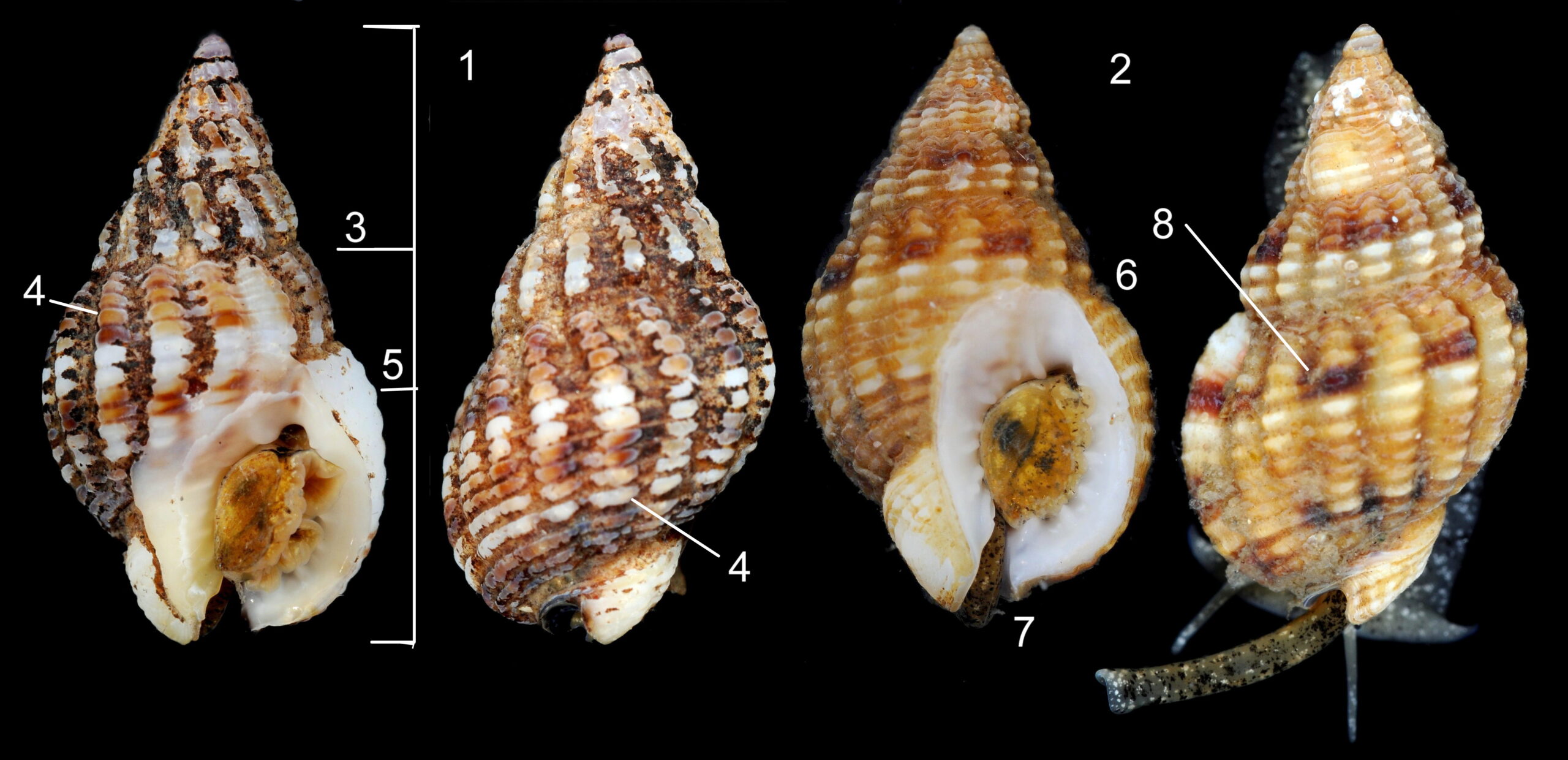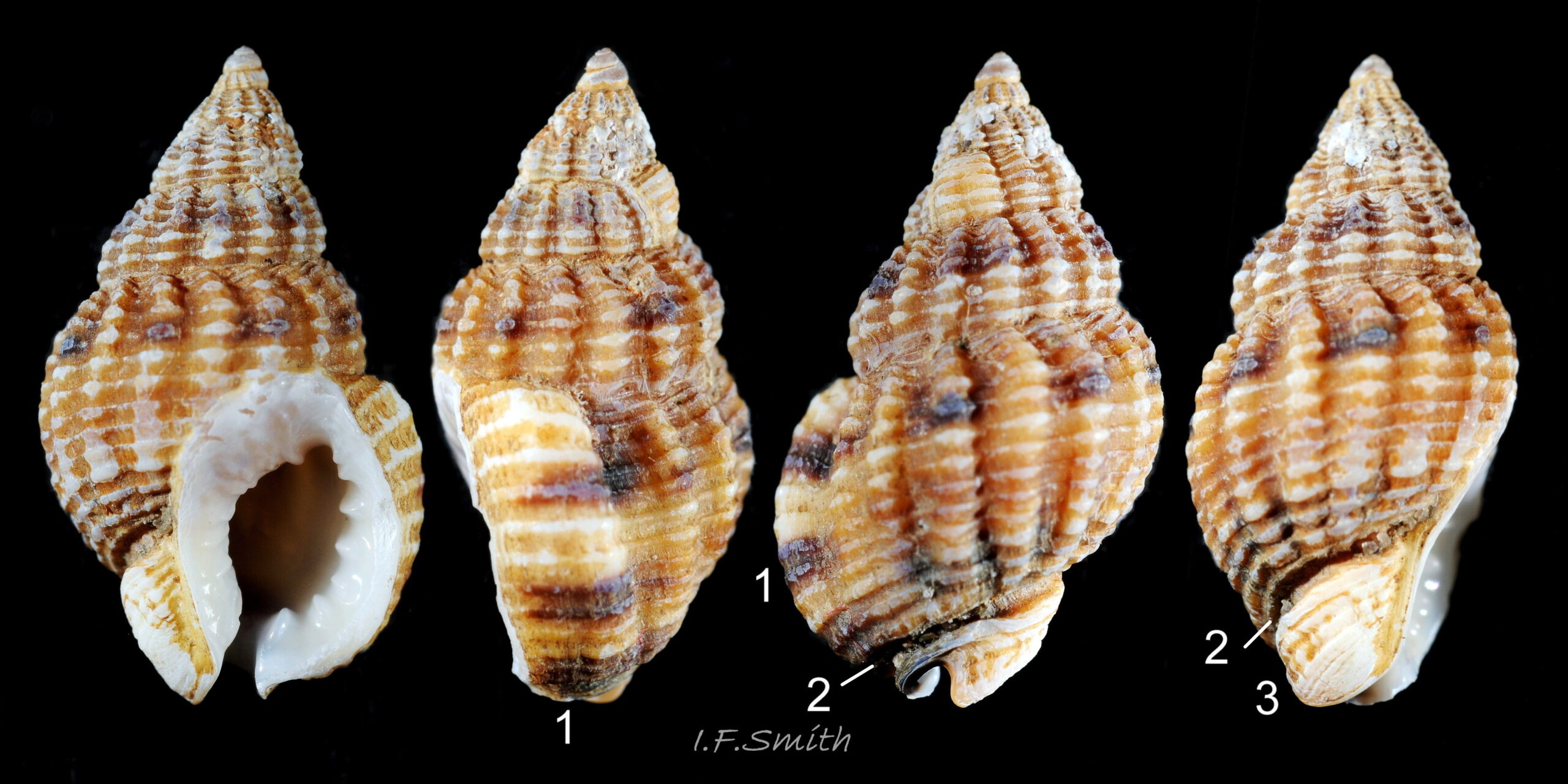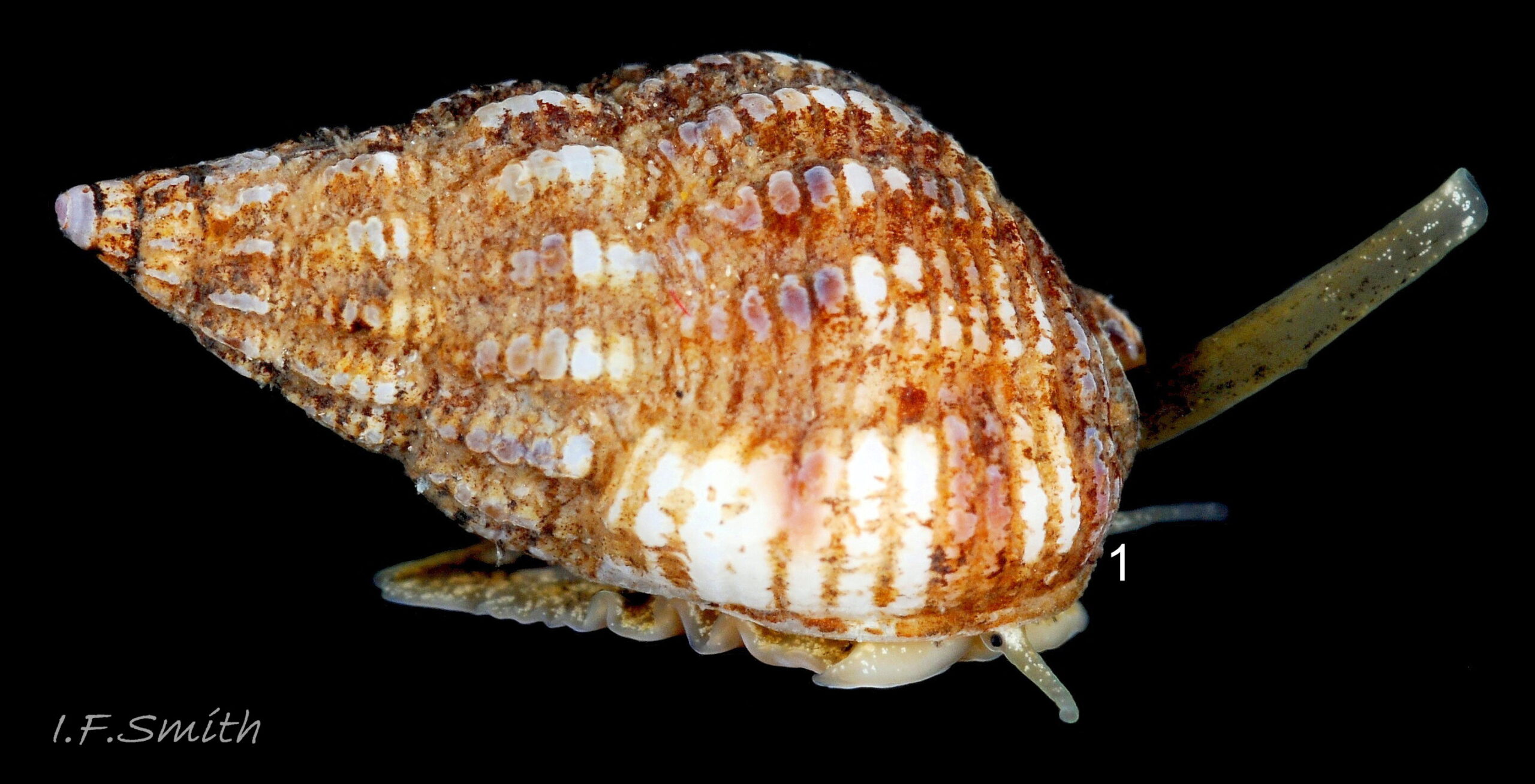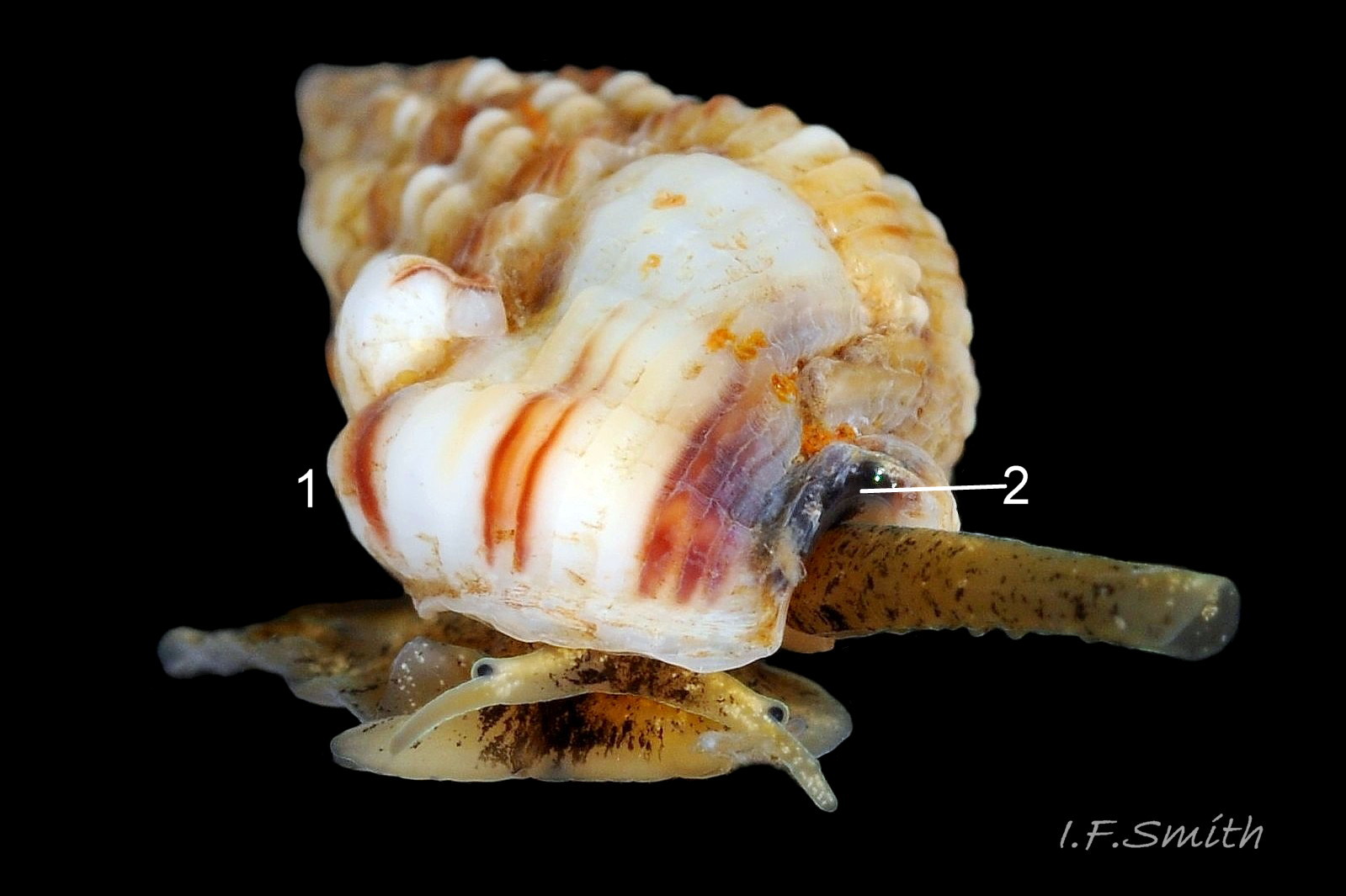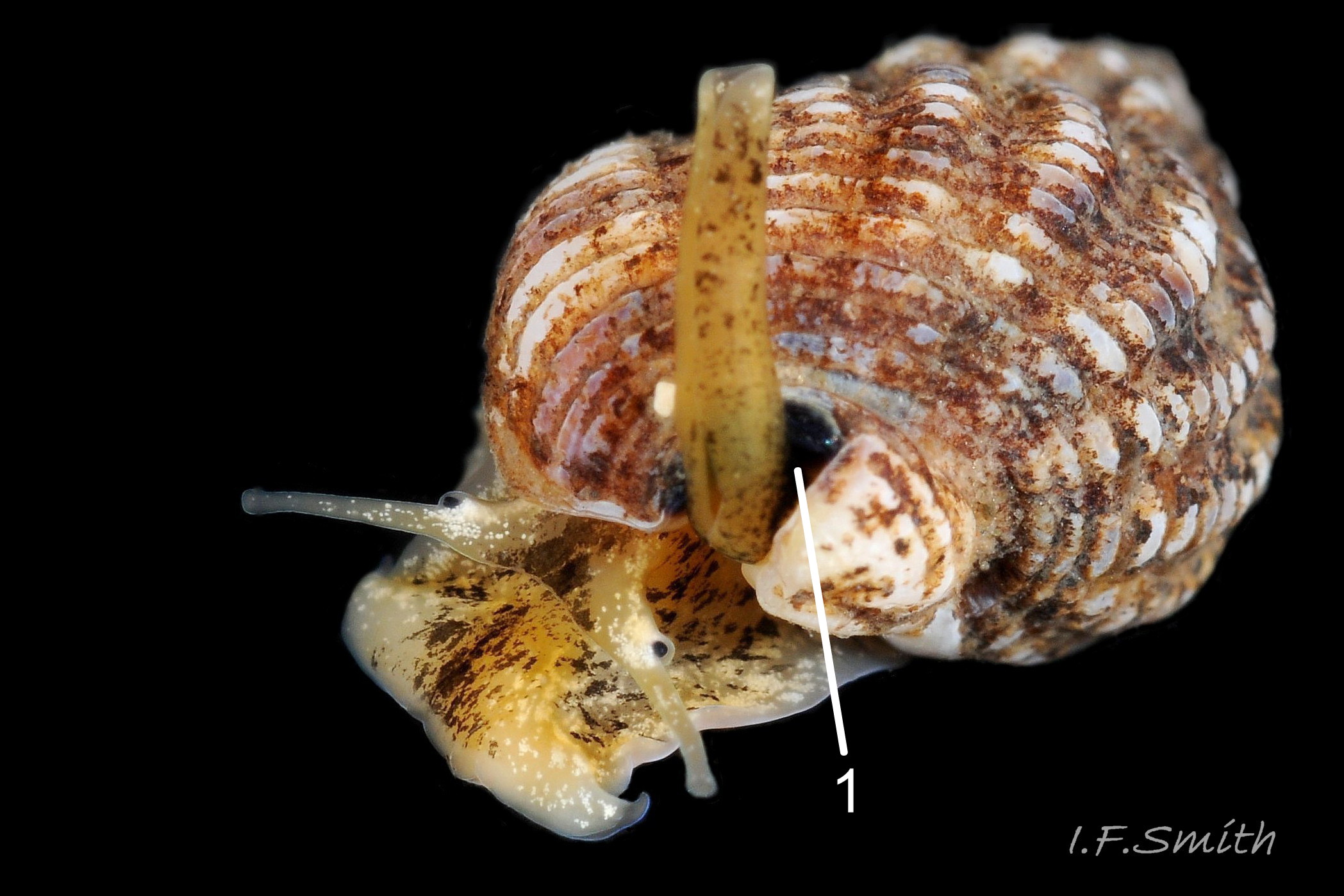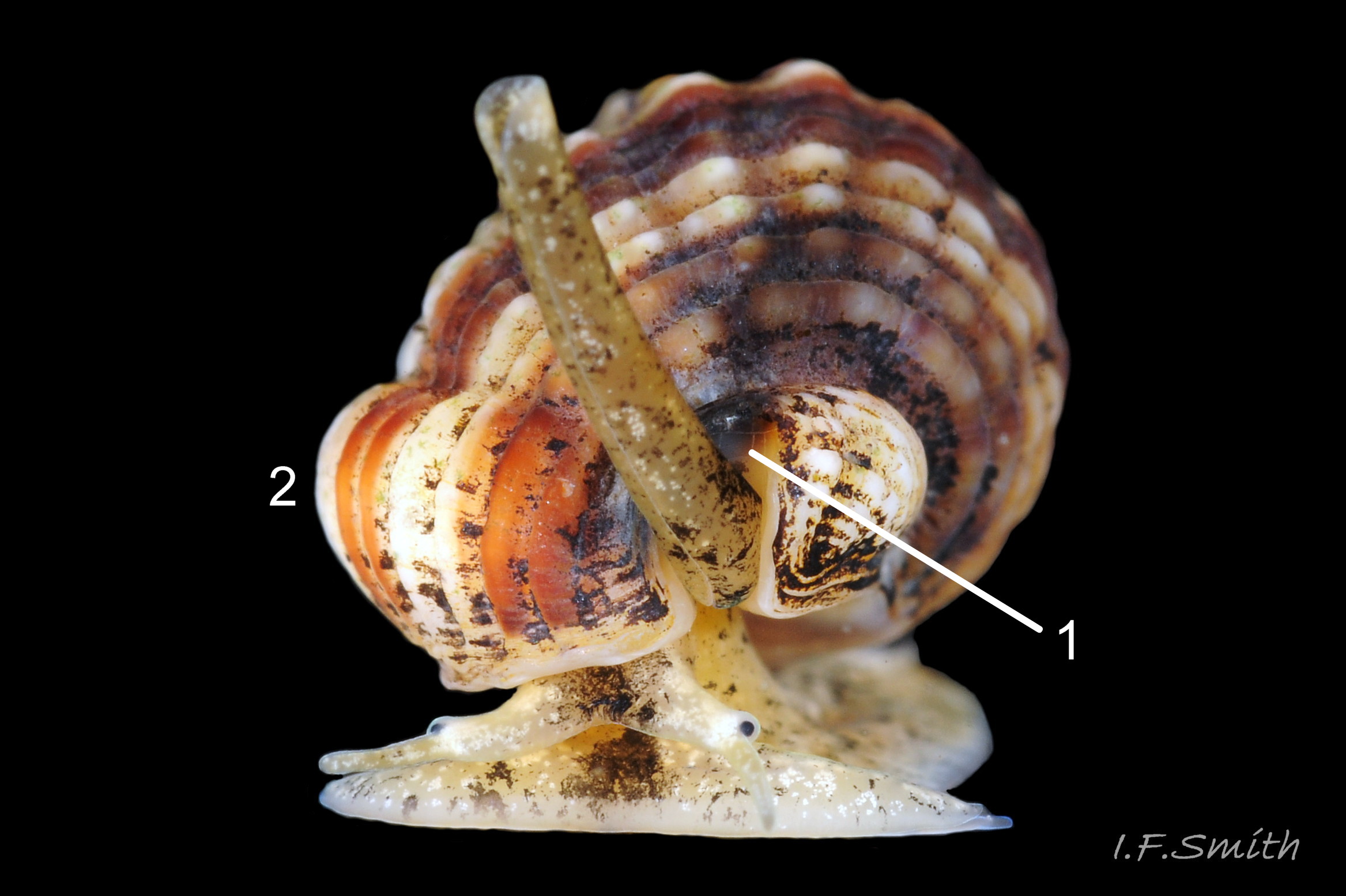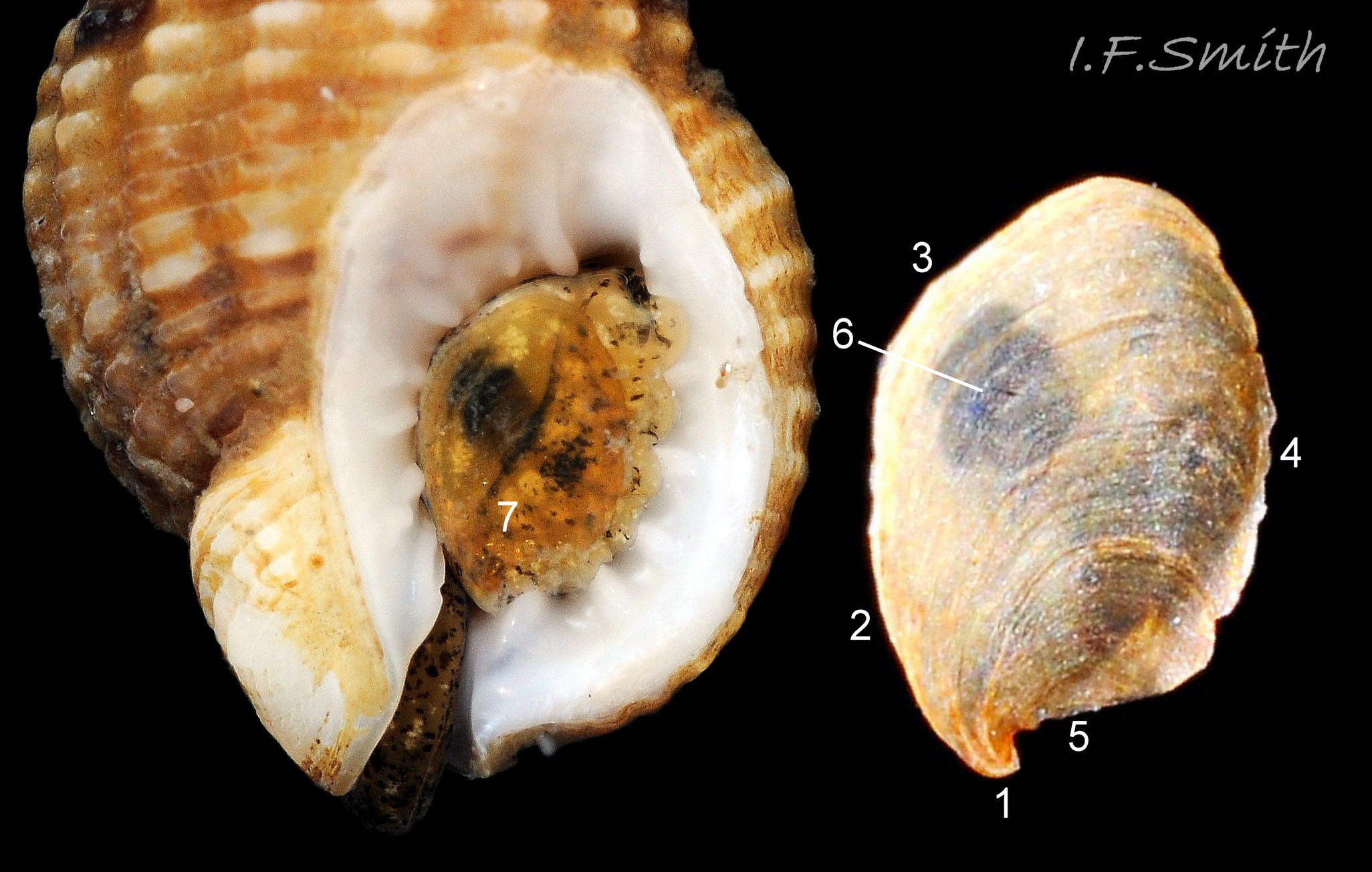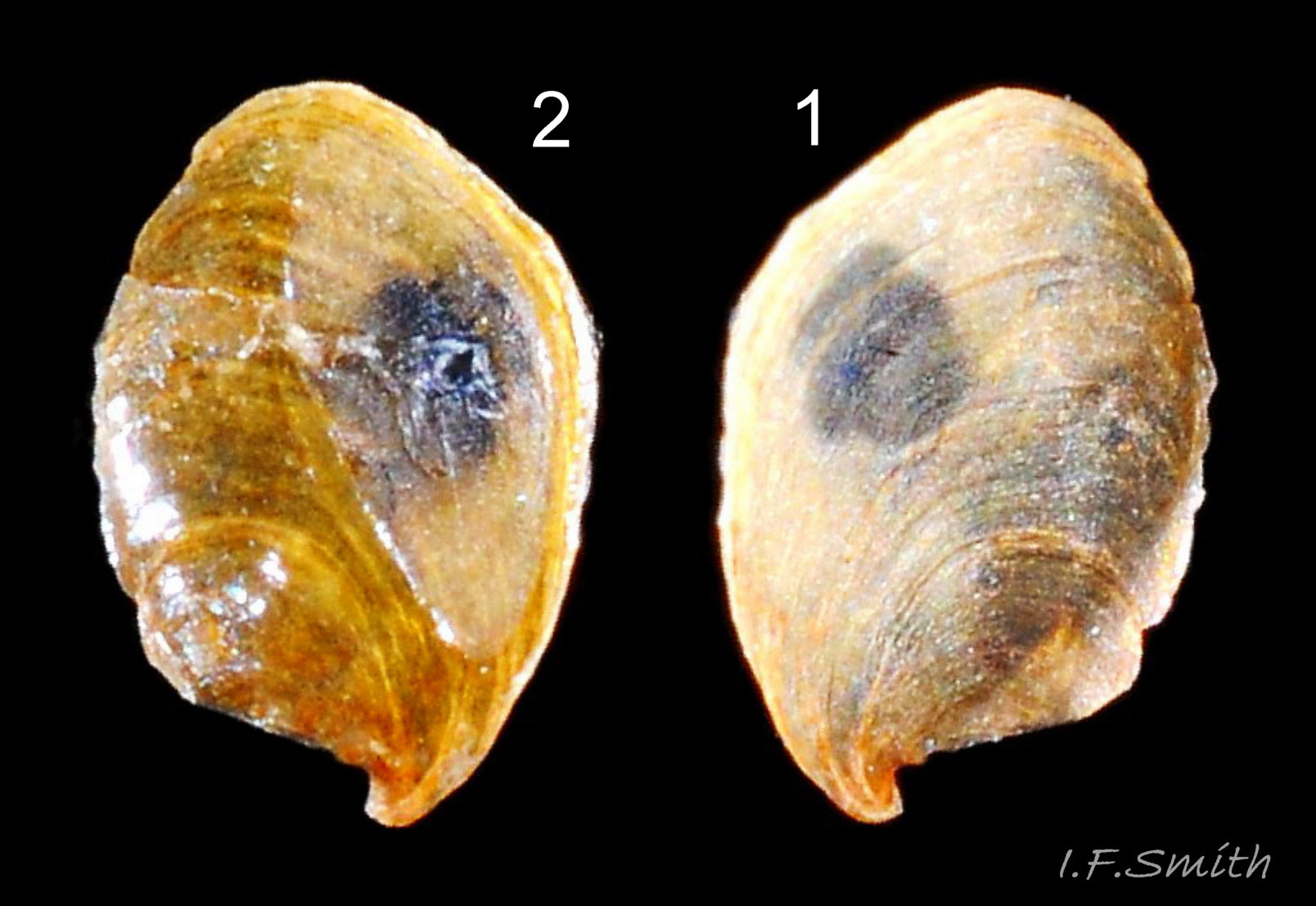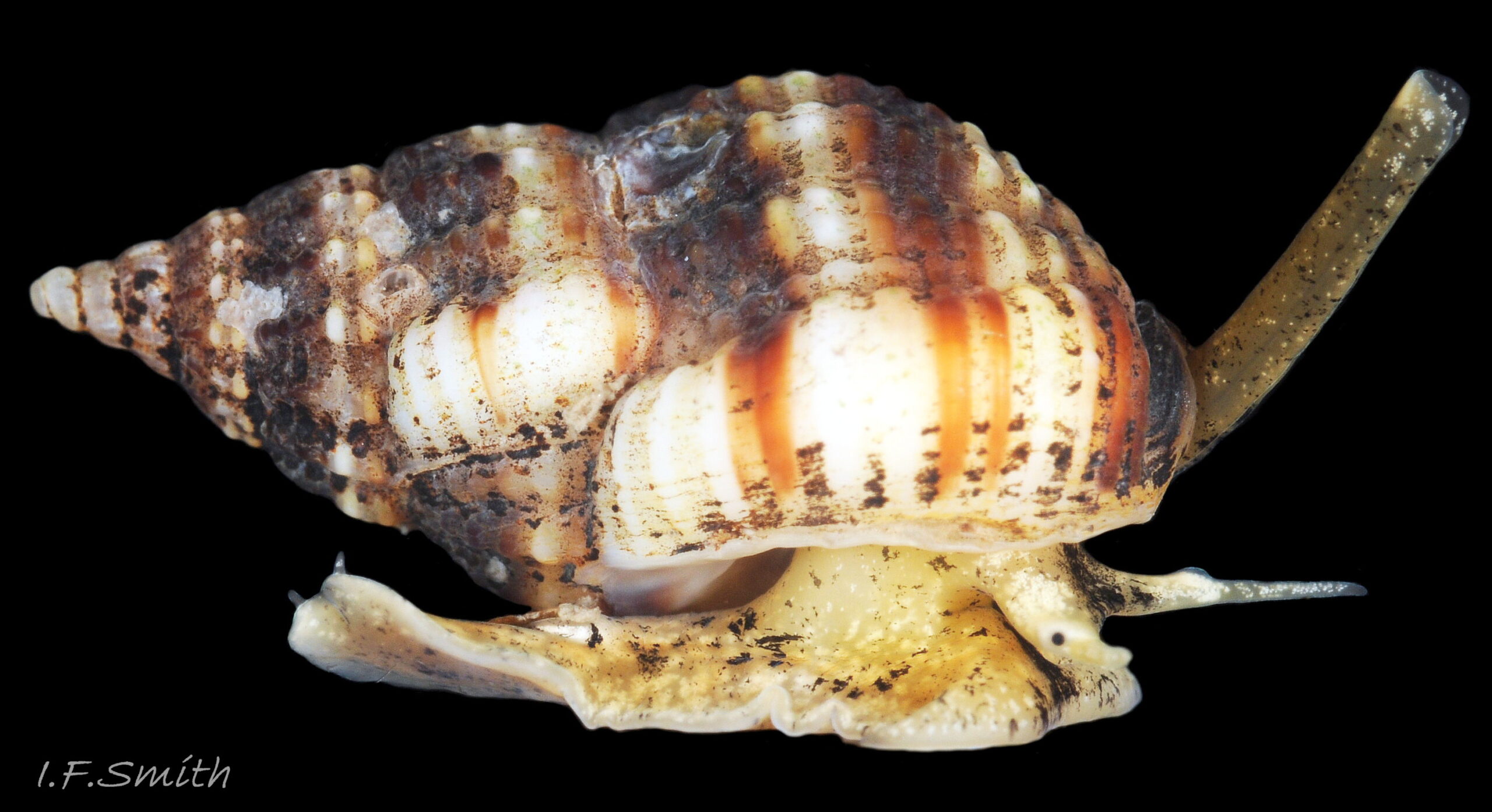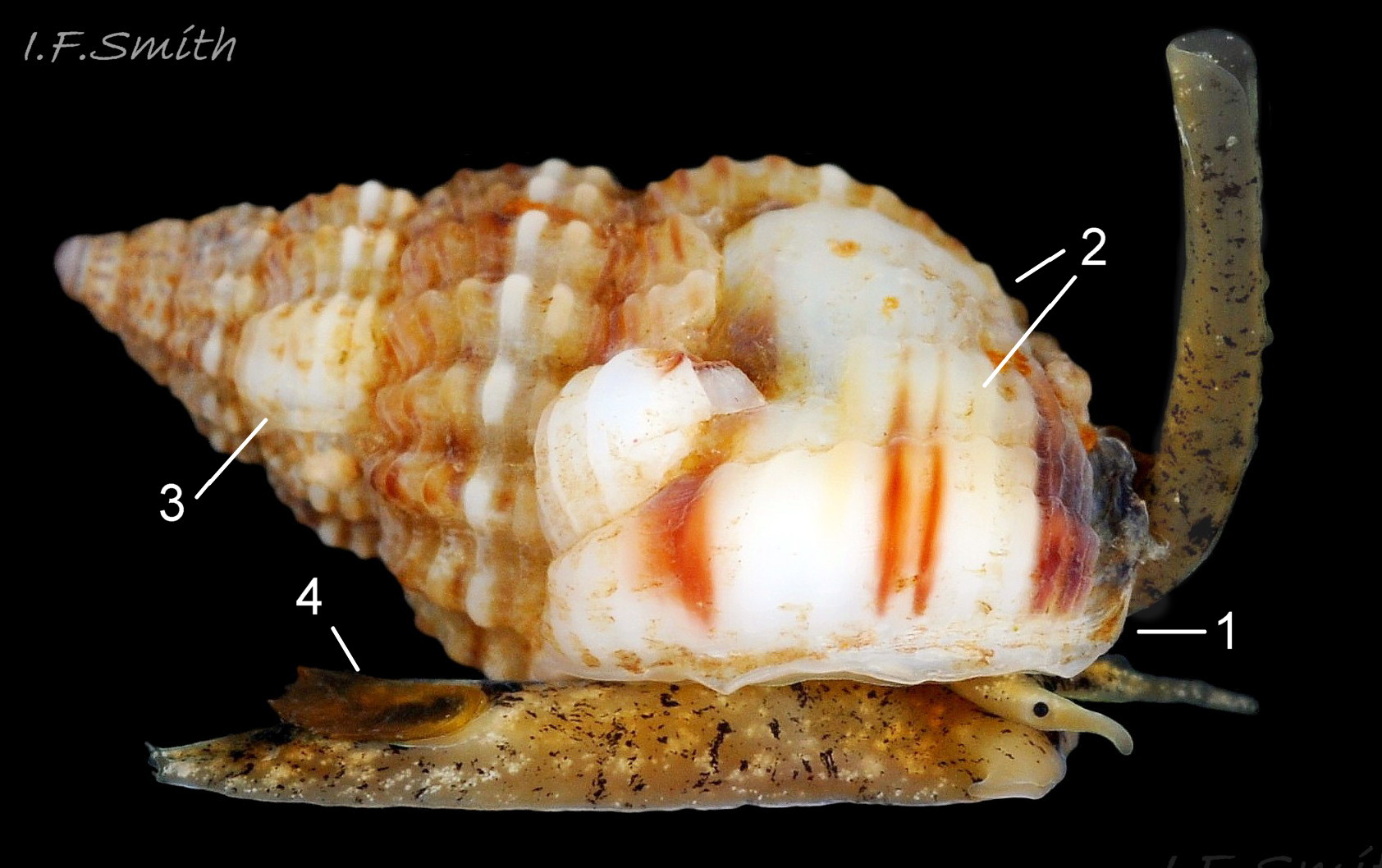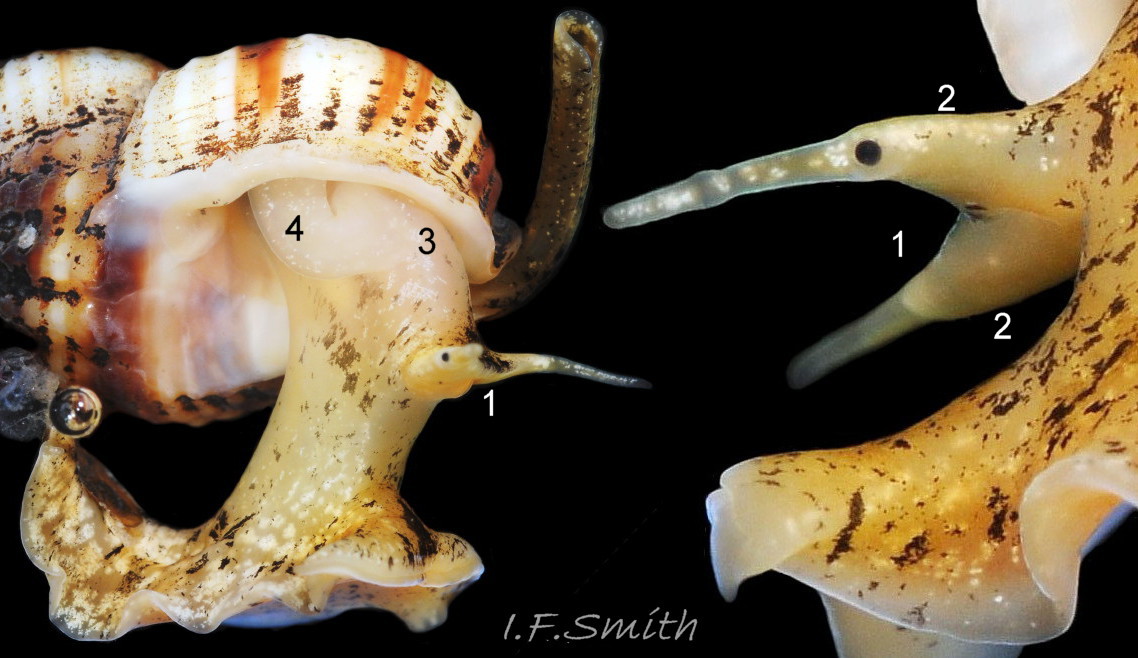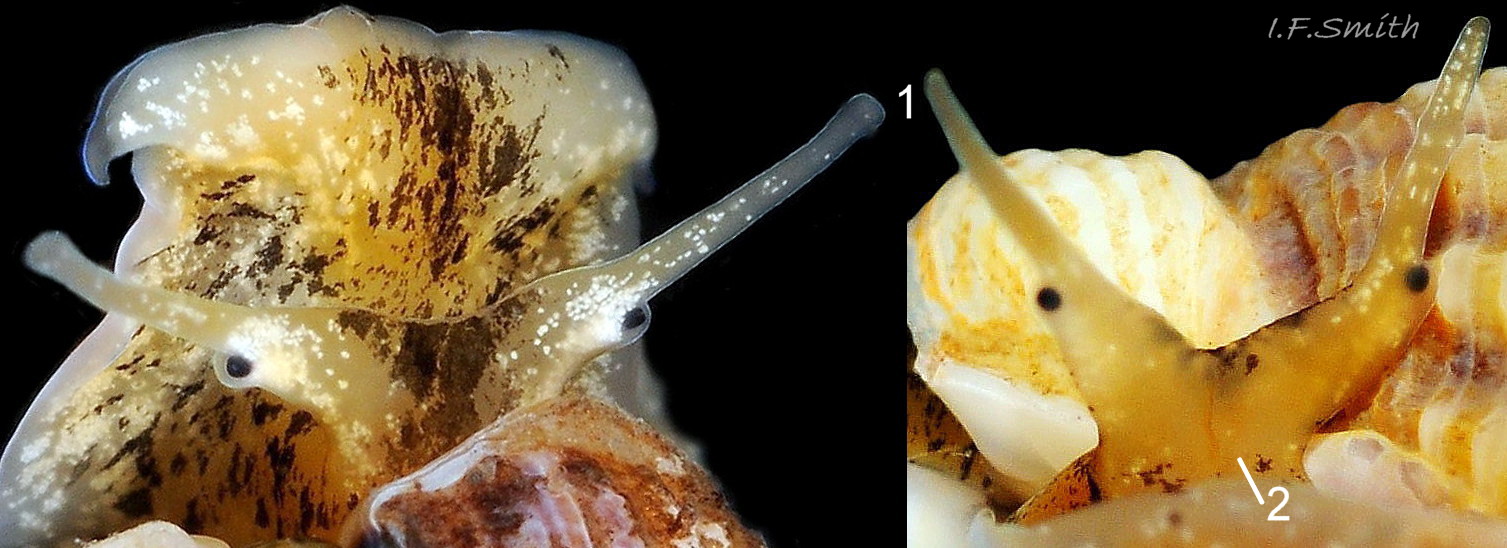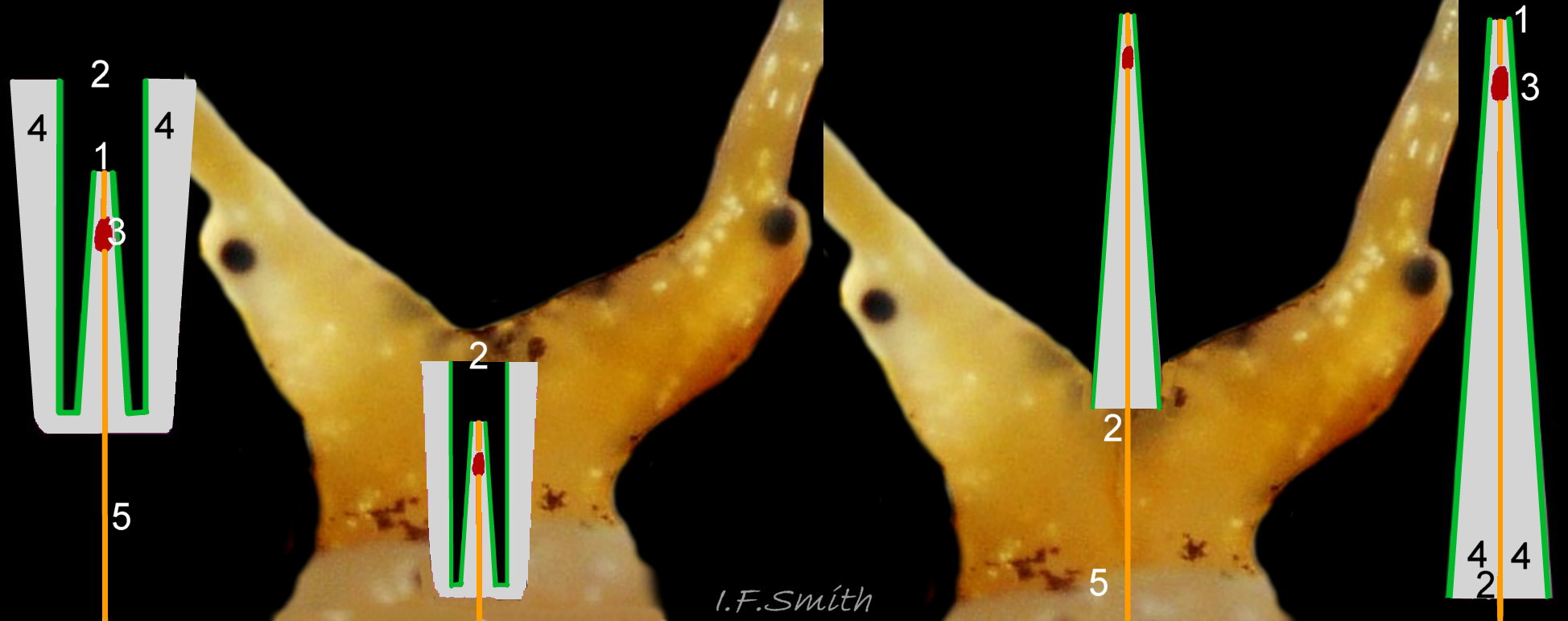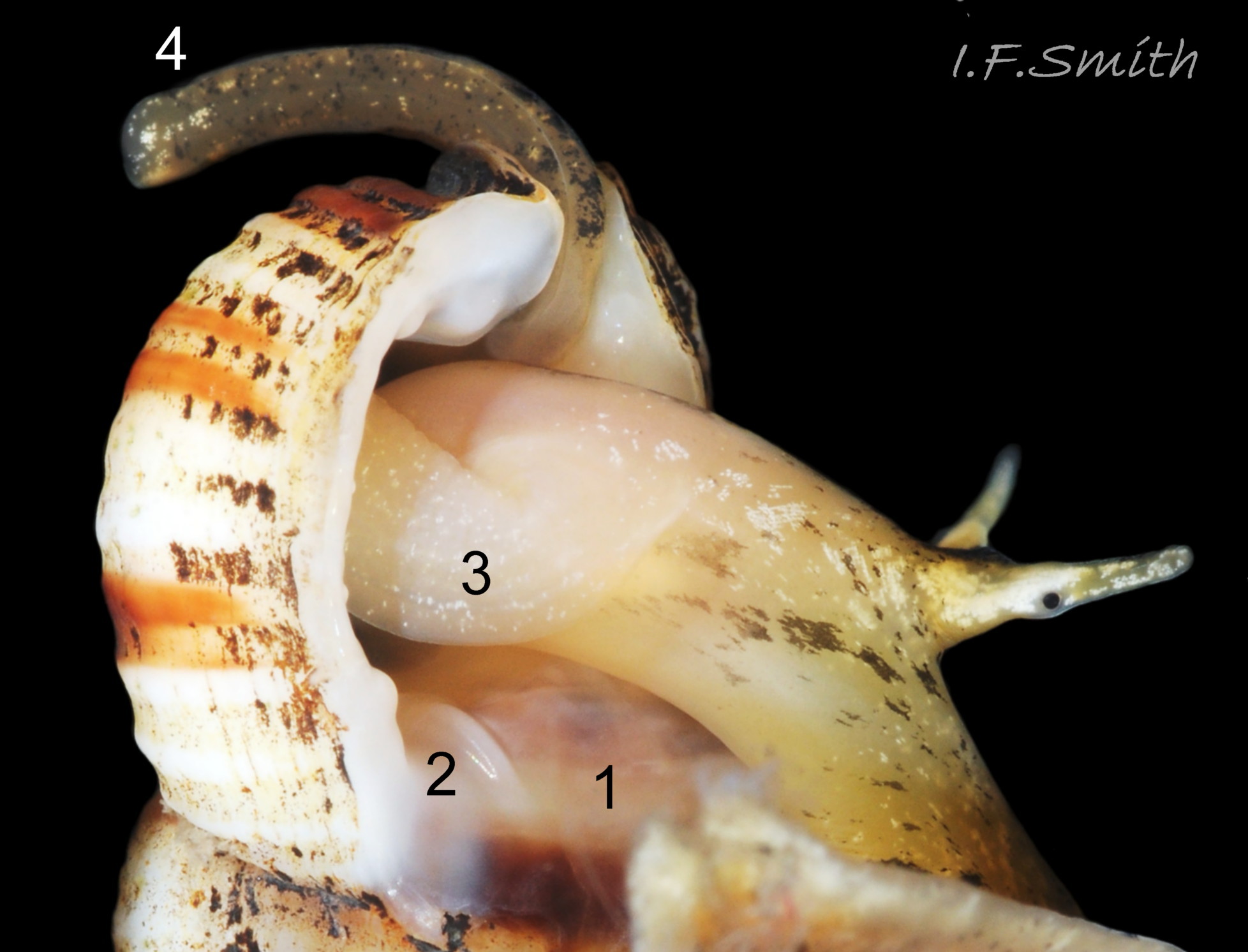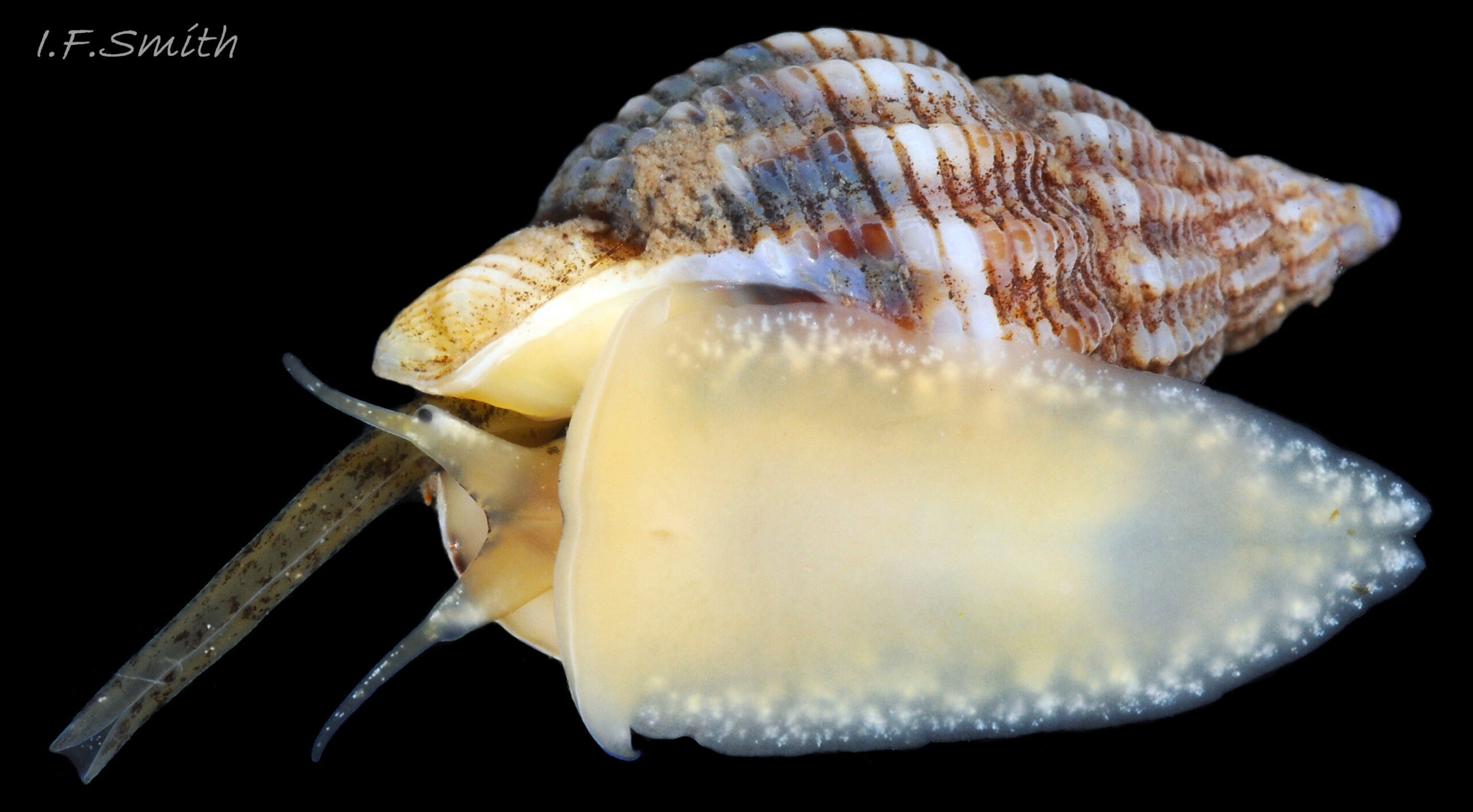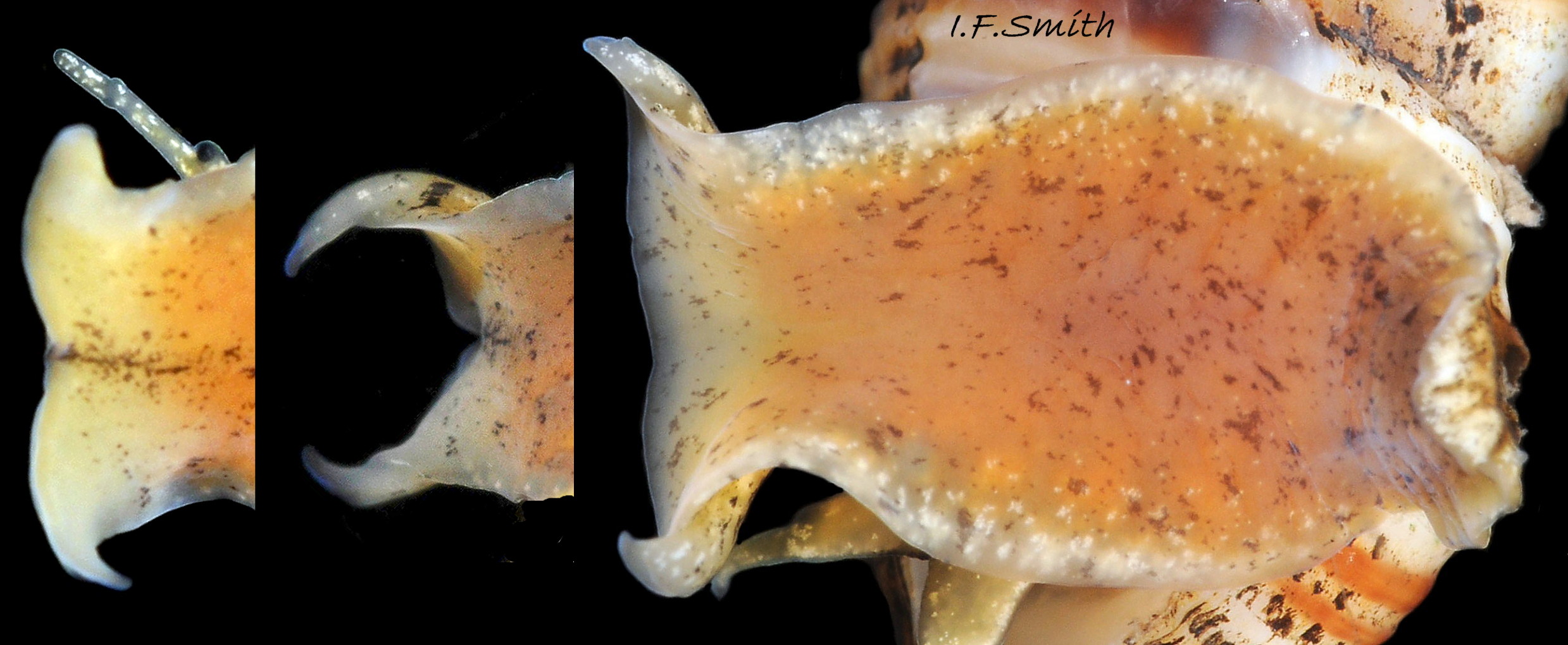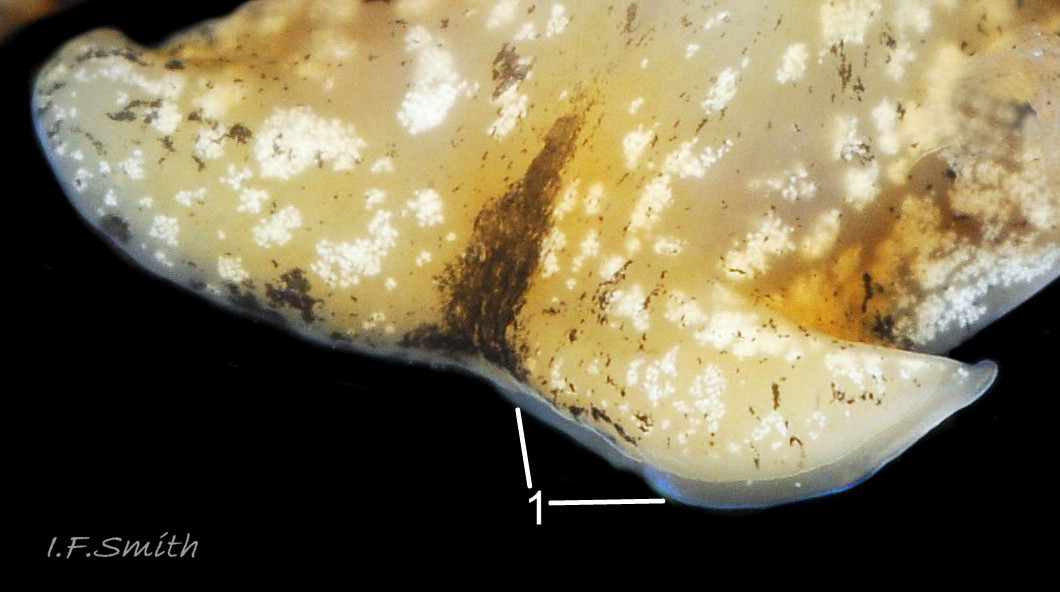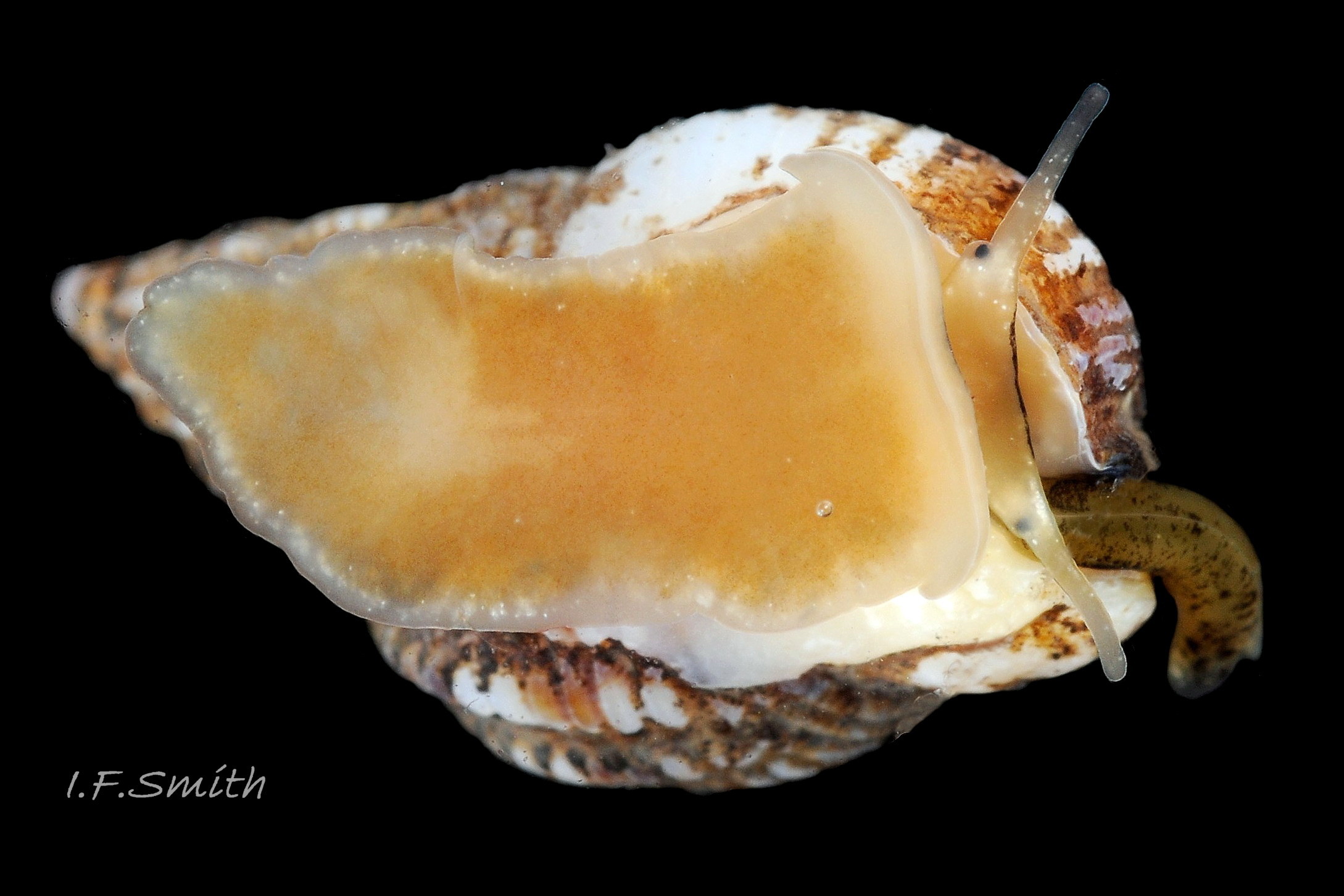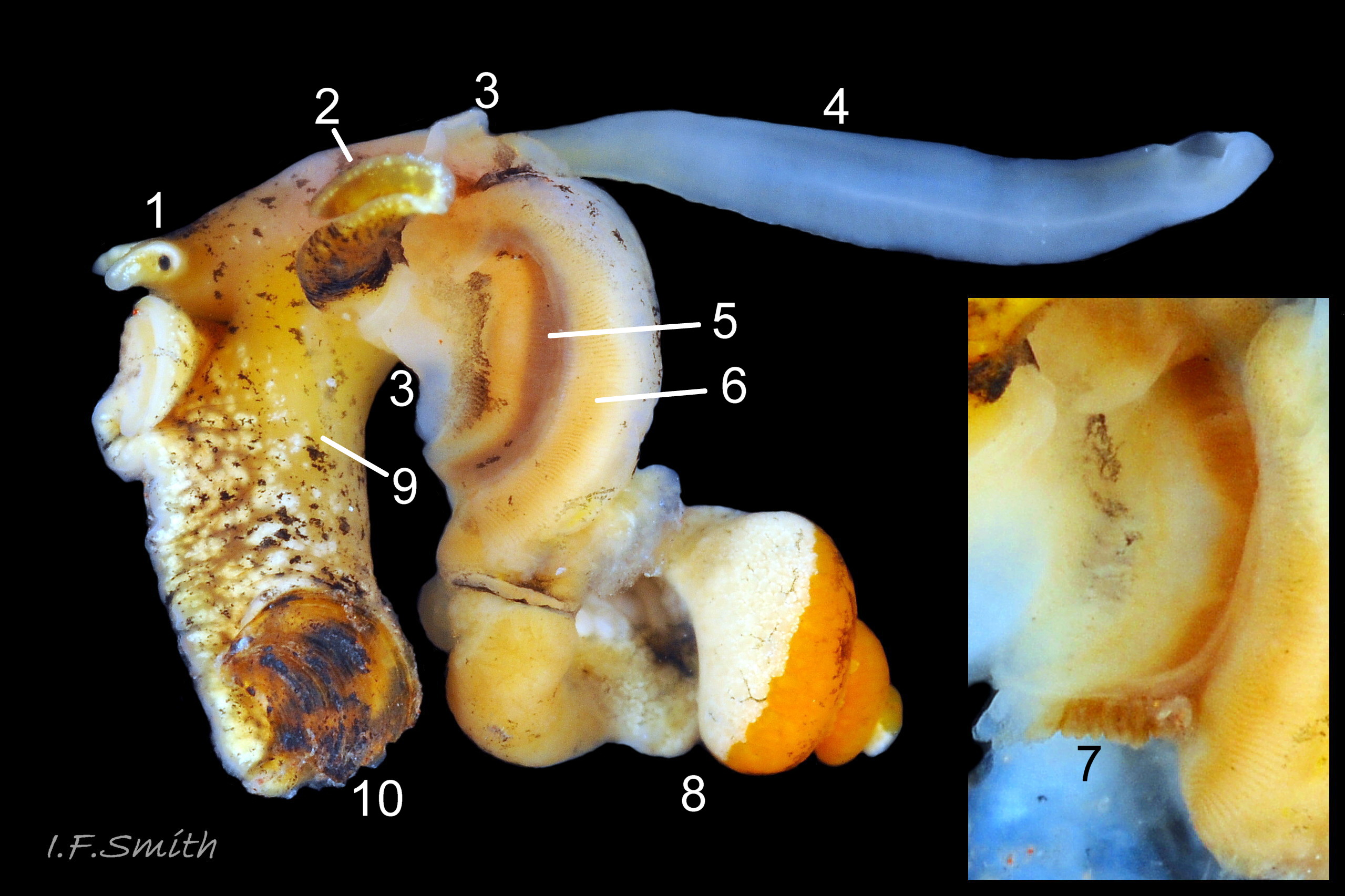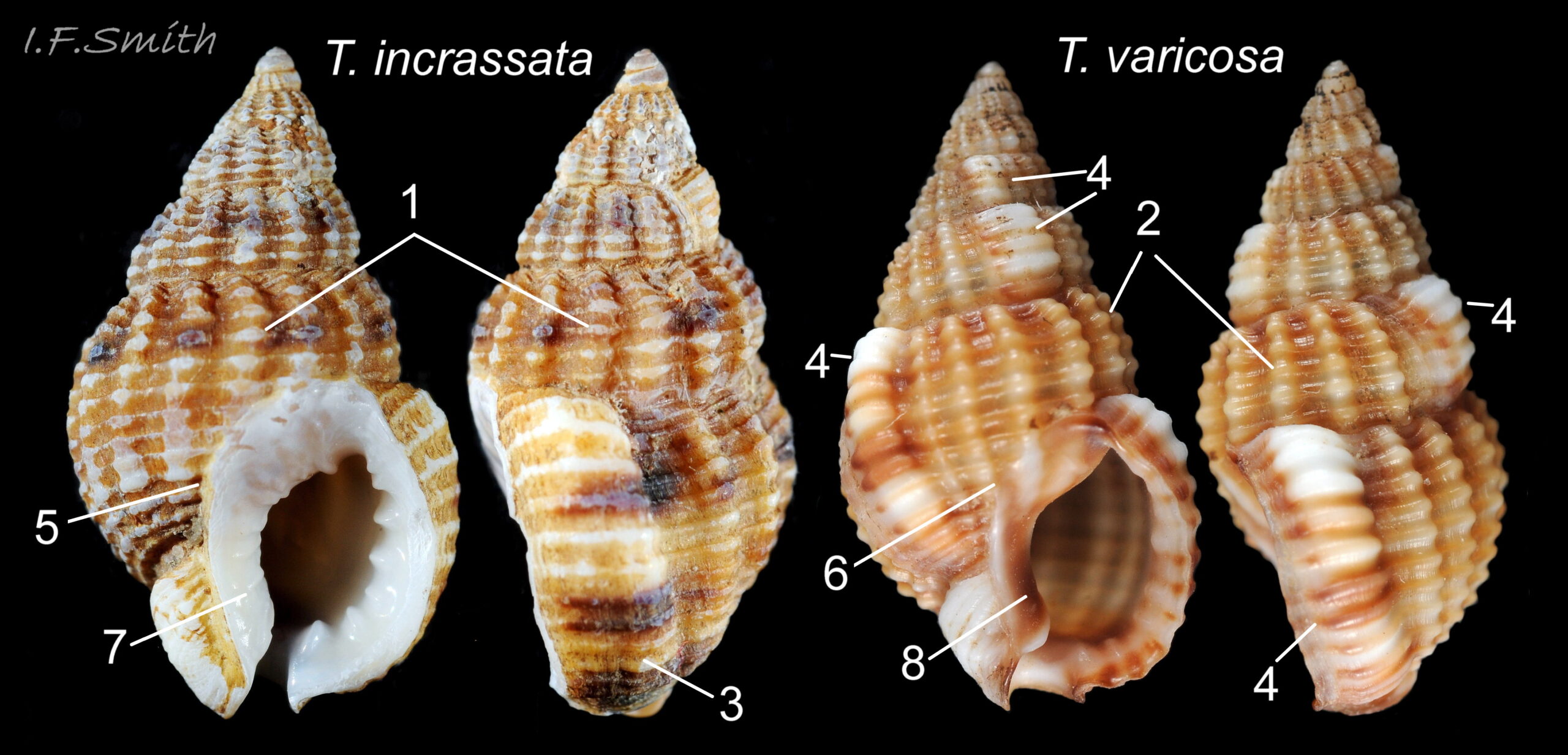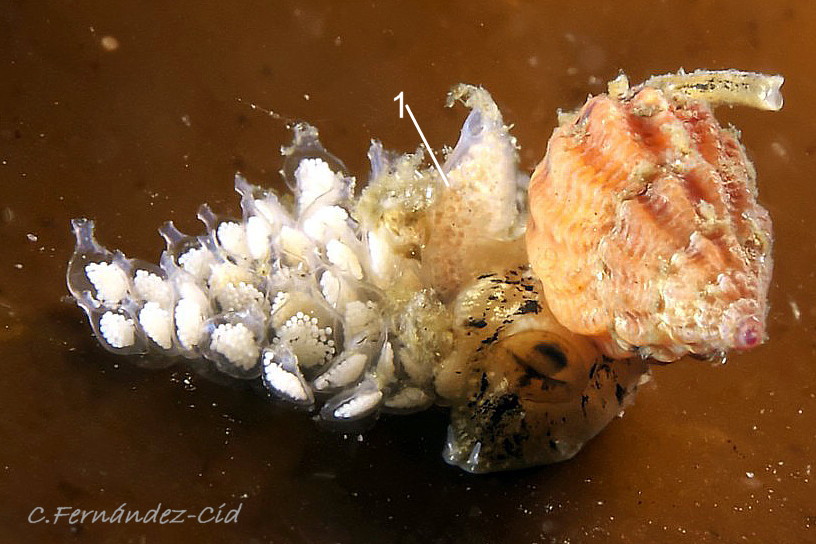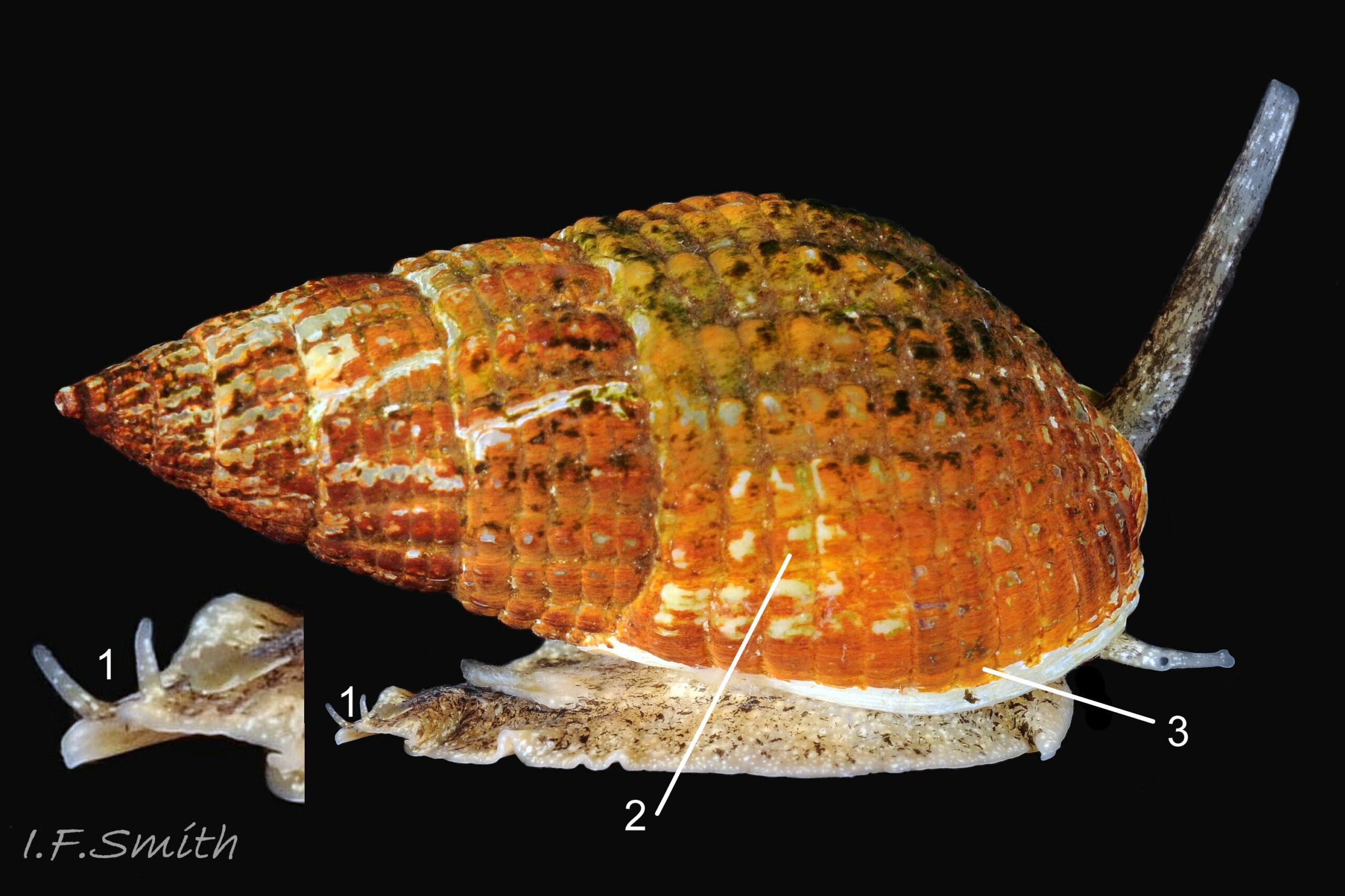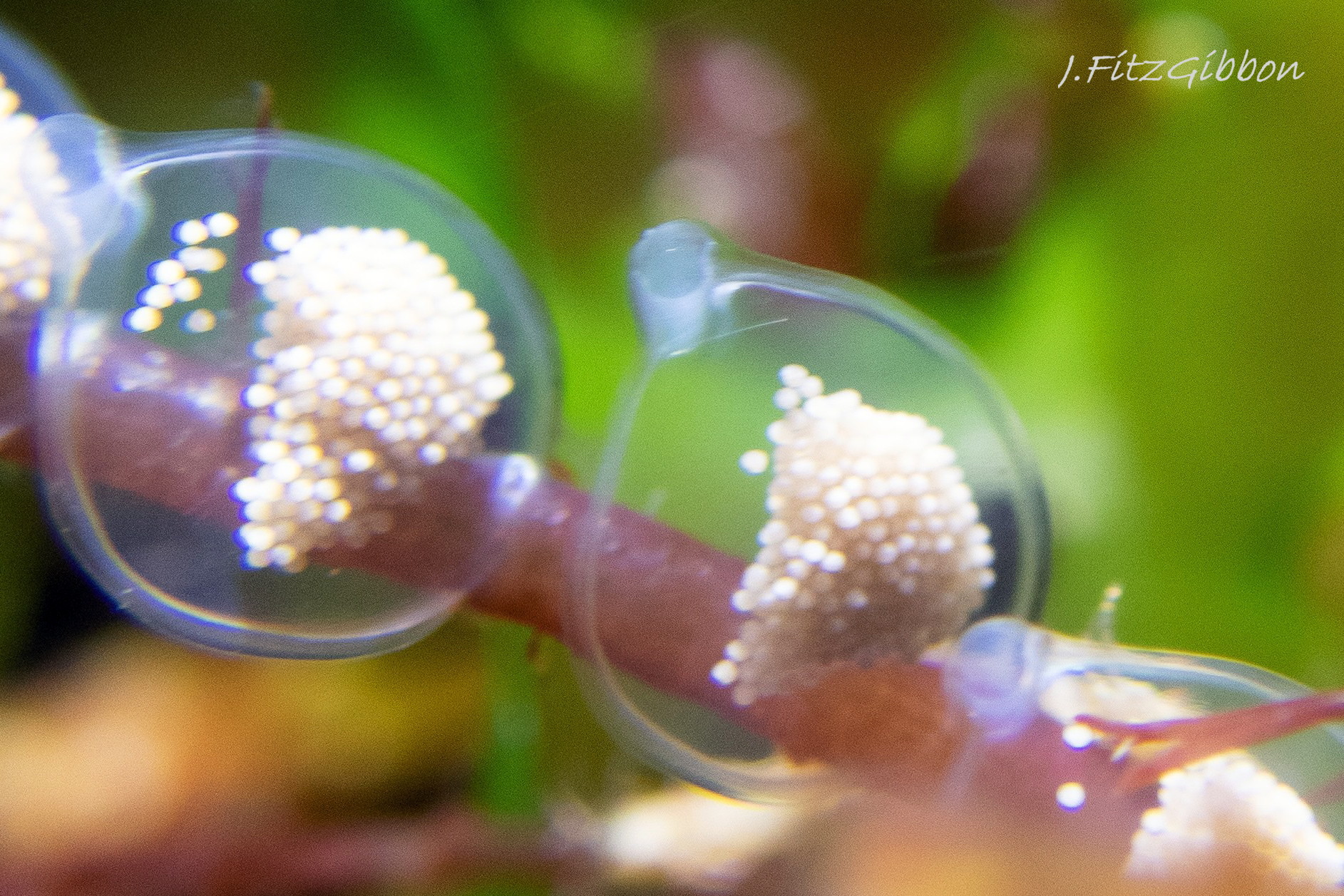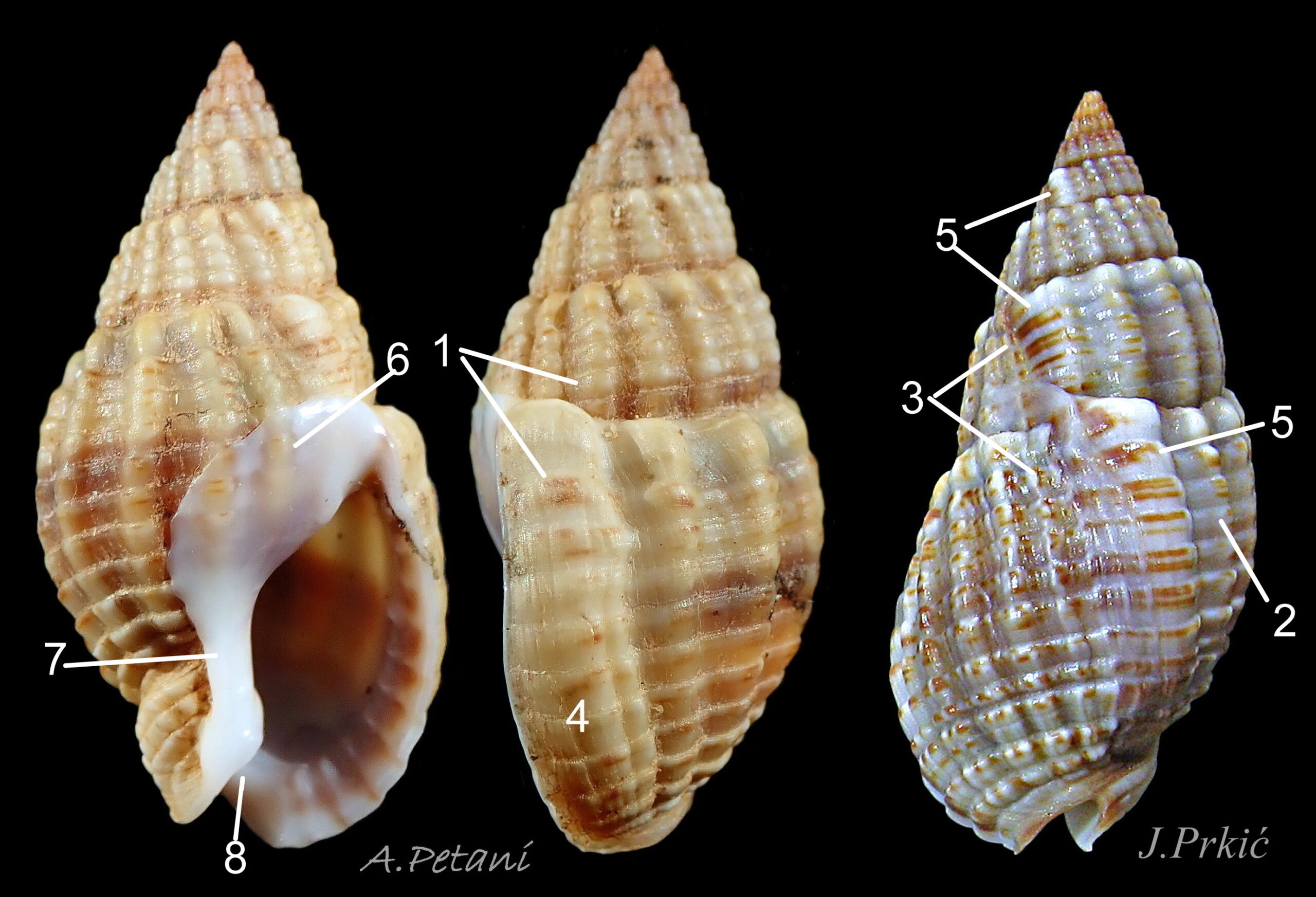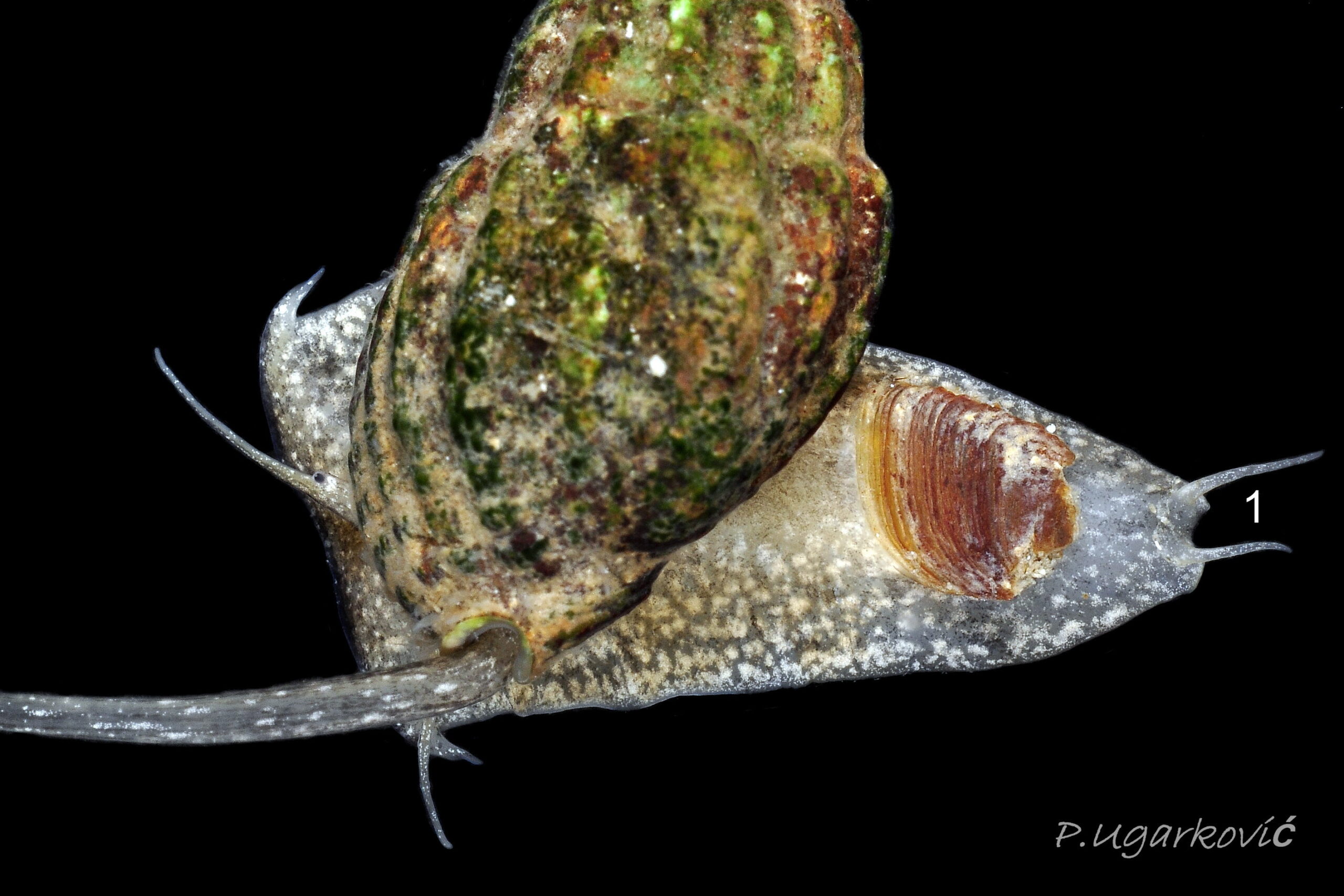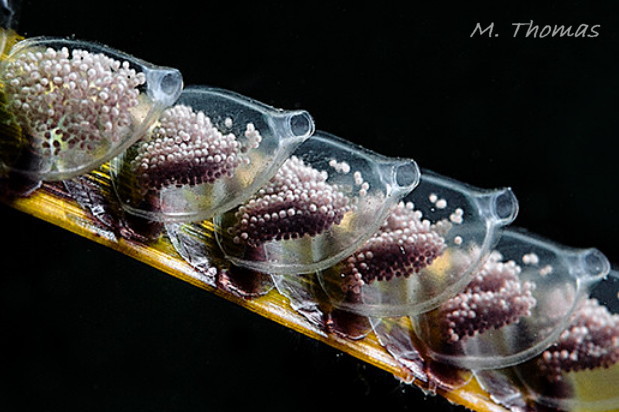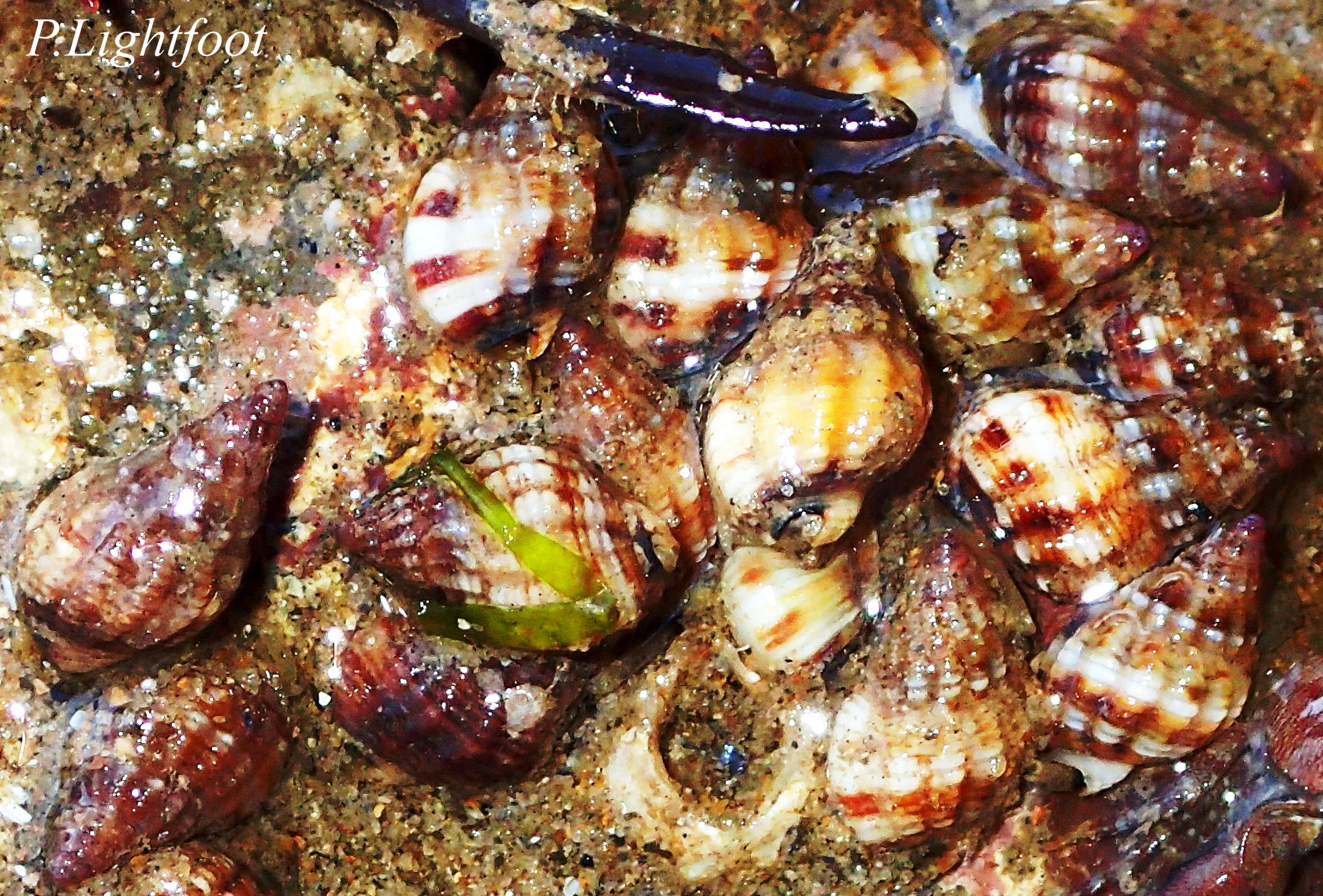Click image to enlarge with full caption. Main text below slider.
Tritia incrassata (Strøm, 1768).
PDF available at www.researchgate.net/publication/368881918_Tritia_incrass…
Synonyms: Buccinum incrassatum Strøm, 1768; Nassarius incrassatus (Strøm, 1768); Hinia incrassata (Strøm, 1768).
Current taxonomy: World Register of Marine Species (WoRMS)
www.marinespecies.org/aphia.php?p=taxdetails&id=876825
Vernacular: Thick-lipped dog whelk (English); Gwichiad moch gweflog (Welsh); Verdikte fuikhoren (Dutch); Dickmundreusenschnecke (German); Petite nasse (French); Tandet dværgkonk (Danish); Πτυχωτό κοφίνι (Greek); nettsnegl (Norwegian).
GLOSSARY below.
Shell description.
The shell has a usual maximum height 12 mm and width 8 mm, rarely 15mm high. It is stout, thick and opaque. The tumid body-whorl is about 70 % of the shell’s height. Spire-whorls are variably tumid, and the profile varies 01 Tritia incrassata . Each whorl of the spire has 12 to 15 strong costal ribs 02 Tritia incrassata , and the body-whorl has 10 to 13 including the one next to the lip which is expanded into a wide, labial varix 03 Tritia incrassata & 04 Tritia incrassata . Usually there are no other varices, but occasional specimens have aberrant growths, perhaps related to damage, and/or an additional varix resembling those often found on T. varicosa13 Tritia incrassata . The ribs on the body-whorl are crossed by 12 to 16 smaller, conspicuous spiral ridges creating oblong bosses at their intersections 01 Tritia incrassata . There is a deep spiral gutter near the base of the body-whorl 02 Tritia incrassata . Below the gutter, the exterior of the siphonal canal has up to 12 spiral ridges but no costal ribs 02 Tritia incrassata . The protoconch, lacking periostracum and obvious sculpture, has a little more than two complete tumid, smooth whorls 05 Tritia incrassata .
When live and uneroded, the exterior of shell is covered by a brown periostracum apart from the protoconch and some of the bosses on the ribs 01 Tritia incrassata . On worn shells the periostracum persists longest in the shelter of the grooves between the costae and spiral ridges.
The height of the oval aperture is about 45% of the shell height 01 Tritia incrassata . On adults all lips are wide and white. The palatal (outer) lip meets the parietal (upper, inner) lip at about 45º and curves smoothly to the distal end of short, deep, oblique, siphonal canal. The canal always has a brown or black mark within it 04 Tritia incrassata & 05 Tritia incrassata , which may fill its full width 06 Tritia incrassata or spread beyond it 07 Tritia incrassata . The white, exposed columella forms a side of the canal and the columellar (lower, inner) lip of the aperture. The palatal (outer) lip is thin on juveniles 05 Tritia incrassata , but as it grows it is thickened with about six white teeth on its inner face. The substantial, parietal lip spreads onto the body-whorl; it and the columellar lip also develop teeth with age 09 Tritia incrassata .
The ground colour of the shell, when periostracum removed is usually pale buff or yellowish white but occasionally purple, pink or orange shells are found. Some shells have spiral bands of brown, black and white 08 Tritia incrassata . Sometimes the bands are discontinuous spiral lines of dark marks 01 Tritia incrassata .
The labial varix is white, often with transverse red-brown bands when the periostracum is worn away 04 Tritia incrassata .
The translucent, horn-coloured operculum is ear-shaped with a narrow ‘ear lobe’ fitting into the siphonal canal 09 Tritia incrassata . Its columellar and parietal edges are relatively smoothly curved. The palatal edge is more ragged with a large indent at the base. On live specimens the area of attachment to the opercular disc is to the columellar/parietal side of a medial black line 09 Tritia incrassata & 14 Tritia incrassata . The line is in the flesh, so not visible when the operculum is detached from the disc. There is usually a blackish blotch on the area of attachment, which is part of the operculum so still visible when it is detached from the disc. The exterior (distal) face of the operculum consists of conchiolin with concentric growth rings 10 Tritia incrassata originating from a peripheral nucleus at the base. The interior (proximal) surface is matt where the opercular disc attaches, and thickly varnished elsewhere.
Body description
The flesh of juveniles is white with a few black marks 11 Tritia incrassatus . Flesh that is frequently exposed beyond the shell by adults is usually pale yellow 12 Tritia incrassata to dark mustard 13 Tritia incrassata or greyish 14 Tritia incrassata , with liberally scattered white and brown/black specks and flakes and some larger dark marks especially at the anterior 06 Tritia incrassata and behind the operculum 14 Tritia incrassata . Flesh that is rarely exposed is white 14 Tritia incrassata & 15 Tritia incrassata .
The small head is dorsoventrally flattened 15 Tritia incrassata and consists of slender, cephalic tentacles with much thicker bases bearing an eye each and a ventral slit which opens a rhynchostome (false mouth) 16 Tritia incrassata for eversion of the pleurembolic feeding proboscis17 Tritia incrassata & 18 Tritia incrassata which can extend to 150% length of the shell; there is no permanently external snout. The radula, buccal mass and true mouth are in the distal end of the proboscis 18 Tritia incrassata . The short rachiglossan radula has in each row of three colourless, transparent teeth a wide, central, rachidian tooth with many small cusps (points) flanked on either side by a longer marginal tooth. The translucent white mantle roofs the mantle cavity and extends with the attached rectum onto the exterior of the body-whorl where it secretes the wide, white parietal lip 19 Tritia incrassata . The mantle also extends as a contractile, respiratory siphon through, and often far beyond, the siphonal canal of the shell. The siphon can be translucent whitish yellow with few black marks 20 Tritia incrassata & 06 Tritia incrassata but usually it is dark yellow or brown with dense mottling of black and some white 19 Tritia incrassata .
When fully spread on a flat surface the large, broad foot is widest at the anterior and curves gently to a posterior medially cleft into a pair of points 21 Tritia incrassata . Dorsally, each point has a small metapodial tentacle which is often held erect 14 Tritia incrassata . The angulated corners (propodial tentacles) are very flexible and can be inconspicuous 22 Tritia incrassata or prominent 23 Tritia incrassata The anterior of the foot and its corners are deeply bilaminate 24 Tritia incrassata with the opening from the anterior pedal mucus gland within. Dorsally the foot is coloured as most of body but the sole is from translucent yellowish white 21 Tritia incrassata to ginger brown 25 Tritia incrassata , showing white marks of the dorsum through the thin translucent edge of the foot. Some also have dark flecks 23 Tritia incrassata .
Behind the right tentacle, males have large, white penisflic.kr/p/2oiBwnib & 26 Tritia incrassata . Removal of the shell 26 Tritia incrassata will show in the mantle cavity a large, yellowish, pinnate ctenidium and a smaller, pinnate, red-brown osphradium resembling a ctenidium in structure.
Key identification features 27 Tritia incrassata and Tritia varicosa
Tritia incrassata
1. Maximum height 12 mm.
2. Shell sculpture of transverse, oblong bosses.
3.Pronounced, broad, labial varix; light brown when covered by periostracum; white, often with transverse red-brown bands, when periostracum worn away. b>Usually no other varices, but occasionally an additional one occurs.
4. Semicircular, glossy, opaque, white parietal lip covers part of body-whorl.
5. All-white columella and siphonal canal with distinct brown or black spot inside canal04 Tritia incrassata & 05 Tritia incrassata .
6. Metapodial tentacles short.
7. Egg capsules similar form to that of T. reticulata, but smaller with longer neck, narrow stalk-base and laid in irregular clumps 28 Tritia incrassata .
8. Norway to Morocco and Mediterranean. Rocky shores all round Britain. Lower shore and sublittoral.
Similar species
Tritia varicosa (W. Turton, 1825) 27 Tritia incrassata and Tritia varicosa
1. Maximum height 14 mm. Despite the vernacular name ‘Small dogwhelk’, probably derived from a synonym’s specific epithet ‘pygmaea’, T. varicosagrows larger than T. incrassata.
2. Shell sculpture of small, well-raised, rounded bosses on unweathered shells.
3. Labial varix on adult shells, and most have one or more additional varix on body-whorl or spire whorls.
4. Brown of body-whorl shows through translucent parietal lip.
5.Columellar lip orange-brown. Often orange-brown at entrance of siphonal canal, but no black or blackish brown further within canal.
6. Metapodial tentacles long (Graham, 1988).
8. Norway to Morocco and Mediterranean. South and west coast of Britain to Shetland. Not Irish Sea. Sublittoral, 1 m to 200 m, sandy substrate; found on bait in crab pots.
Tritia reticulata 29 Tritia incrassata and Tritia reticulata
1. Maximum height 30 mm; much larger than T. incrassata.
2. Shell sculpture a reticulate arrangement of low, squarish bosses
3. The final costa is rarely sufficiently thickened to form even a slight labial varix.
4. Semicircular, glossy, opaque, white parietal lip covers large part of body-whorl.
5. White columella and siphonal canal. No dark spot within canal.
6. Metapodial tentacles relatively short 30 Tritia incrassata COMPARE Tritia reticulata .
7. Egg capsules like a flat, circular brandy bottle that broadens with age 31 Tritia incrassata COMPARE Tritia reticulata . Mean height 4.07mm, width 3.25mm (Rolan & Luque, 1994).
8. Sandy sediment sublittorally, and LWS on rocky shores with areas of sand, all round Britain and Ireland.
Tritia nitida (Jeffreys, 1867) 32 Tritia incrassata COMPARE Tritia nitida .
1. Maximum height 30 mm (40 mm in Italian Adriatic) .
2. Thickness and spacing of costal ribs varies so bosses vary between squarish and transverse or longitudinal oblongs 33 Tritia incrassata COMPARE Tritia nitida .
3. Labial varix on almost all shells over 15 mm high 32 Tritia incrassata COMPARE Tritia nitida , and additional varix on body-whorl occasionally in Britain, and more frequently in Adriatic 33 Tritia incrassata COMPARE Tritia nitida . In Britain the varix is usually less pronounced than on T. incrassata; sometimes little more than a slightly thickened costa, and lost or inconspicuous on some beach worn strandline shells. Adriatic specimens can have very prominent varices .
4. In Britain, parietal lip translucent showing shell colour beneath 32 Tritia incrassata COMPARE Tritia nitida ; not as extensive, white or distinct as on T. reticulata, but strong and opaque on some T. nitida in Adriatic 33 Tritia incrassata COMPARE Tritia nitida .
5. White columella and siphonal canal. No dark spot within canal.
6. Metapodial tentacles long 34 Tritia incrassata COMPARE Tritia nitida .
7. T. nitida egg capsules are ovoid with the vertical axis longest; mean height 2.65 mm, width 1.72 mm (Rolan & Luque, 1994) 35 Tritia incrassata COMPARE Tritia nitida .
8. Sublittoral on muddy substrate in sheltered, variable salinity on Atlantic coasts. Scattered sites Spain to southern Sweden; more continuous distribution in Mediterranean beyond Barcelona, and in Black Sea at variable, often high, salinity.
Habits and ecology
T. incrassata lives under stones and in crevices at LWST and sublittorally to 200 m depth on ground with a mixture of hard substrates such as rock, stones and shells and soft substrates of sand, gravel and, especially, silt and organic detritus. It scavenges on dead organisms, including fish, crabs and sponges, and large congregations 36 Tritia incrassata may be attracted by the scent of rotting carrion, so is often found on bait in lobster and whelk pots or on fish caught in nets. If the carrion is under sediment it can push in its long proboscis which has a sucker-like tip to cling to the food while rasping with its radula. Its flexible foot can wrap round and, with the propodial tentacles, manipulate its food.
The long respiratory siphon enables it to inhale uncontaminated water clear of the decaying food or covering sediment. Inhalent water has its quality checked by the pectinate osphradium at the inner end of the siphon before passing through the larger pectinate ctenidium.
It is a very active species but no muscular waves can be detected on the sole as it moves. It seems to glide smoothly and is probably propelled by cilia covering the sole (Fretter & Graham, 1962).
It breeds in spring and summer at Plymouth. The male’s penis, about 60% the length of the shell 26 Tritia incrassata , fertilizes the female internally. When about to lay the female inspects with her siphon the intended laying surface on weed or hard surface roughened with hydroid or bryozoa and cleans it with her radula if required (Fretter & Graham, 1962). She settles with her right side raised to form a groove from the genital opening to the ventral pedal gland. An egg capsule from the oviduct is manipulated by foot muscles along the groove into the gland where it is moulded for about five minutes. The sole is pressed against the substrate and the visceral mass may rock as the capsule is fixed to the laying-surface 26 Tritia incrassata . Then the anterior of the foot is drawn back to leave the capsule. Several capsules are laid close together, and other females often lay together.
Egg capsules (H.1.5 mm to 2 mm) of T. incrassata are smaller than those T. reticulata (H. 4 mm). They are of a similar form, but with a longer neck, narrow stalk-base, about 50 opaque white ova and are laid in irregular clumps on hydroids, bryozoa, algae and only occasionally on Zostera28 Tritia incrassata (Lebour, 1931). The eggs hatch into veliger larvae which live in the plankton for over two months. By week 13 of development, the velum has four extremely long lobes, more than twice the length of the larval shell, with a large black pigment spot near the end of each lobe, the shell hanging down and a foot capable of crawling (Lebour, 1931). Veligers are found in the plankton at Plymouth from April to October, most numerously from May to August. This stage is the primary dispersal means for the species. Settlement and metamorphosis to adult form is from July to September at Plymouth and in September numerous individuals less than 2 mm high occur on the shore at LWST (Wigham & Graham, 2018).
Distribution and status
T. incrassata has been recorded along Atlantic coasts from Lofoten, Norway to Morocco and the Canary Islands, and in the Mediterranean, but not in the inner Baltic or Black Sea. GBIF map www.gbif.org/species/8632060 . It is common in suitable habitats all round Britain and Ireland, NBN map species.nbnatlas.org/species/NHMSYS0021185423 .
Acknowledgements
For use of images I thank Carlos Fernández-Cid, Joe FitzGibbon, Paula Lightfoot, Alen Petani, Jakov Prkić, Erling Svensen, Mark Thomas and Pero Ugarković. I thank Simon Taylor, for supplying specimens.
Links and references
Couceiro, L., López, L., Sotka, E.E., Ruiz, J.M. & Barreiro, R. 2012. Molecular data delineate cryptic Nassarius species and characterize spatial genetic structure of N. nitidus. J. Mar. Biol. Ass. 92(5): 1175 to 1182.
Forbes, E. & Hanley S. 1849-53. A history of the British mollusca and their shells. vol. 3 (1853), London, van Voorst. (As Nassa incrassata)
archive.org/details/historyofbritish03forbe/page/391/mode…
Fretter, V. and Graham, A. 1962. British prosobranch molluscs: their functional anatomy and ecology. London, Ray Society.
Fretter, V. and Graham, A. 1985. The prosobranch molluscs of Britain and Denmark. Part 8 – Neogastropoda. Suppl. 15, J. Moll. Stud.
Graham, A. 1988. Molluscs: prosobranch and pyramidellid gastropods. Synopses of the British Fauna (New Series) no.2 (Second edition). Leiden, E.J.Brill/Dr. W. Backhuys. 662 pages.
Hayward, P.J. & Ryland, J.S. (eds.) 1995. Handbook of the marine fauna of North-West Europe. Oxford University Press.
Høisæter, T. (2009). Distribution of marine, benthic, shell bearing gastropods along the Norwegian coast. Fauna Norvegica, 28: 5-106. doi.org/10.5324/fn.v28i0.563
Jeffreys, J.G. 1862-69. British conchology. vol. 4 (1867). London, van Voorst. (As Nassa incrassata) archive.org/details/britishconcholog04jeffr/page/351/mode…
Lebour, M. V. 1931. The larval stages of Nassarius reticulatus and Nassarius incrassatus. J. Mar. Biol. Ass., 17 (3). 797-818. plymsea.ac.uk/id/eprint/697/
McKay, D.W. & Smith, S.M. 1979. Marine Mollusca of East Scotland. Edinburgh, Royal Scottish Museum.
McMillan, N.F. 1968. British shells. London, F.Warn.
Rolan, E. and Luque, A.A. 1994. Nassarius reticulatus (Linnaeus, 1758) and Nassarius nitidus (Jeffreys, 1867) (Gastropoda, Nassariidae), dos especies válidas de los mares de
Europa. Iberus, 12 (2): 59-76.
Sanjuan, A., Pérez-Losada, M. & Rolan, E. 1997. Allozyme evidence for cryptic speciation in sympatric populations of Nassarius spp. (Mollusca: Gastropoda). J. Mar. Biol. Ass. 77(3): 773 to 784.
Trigo, J.E.; Diaz Agras, G.J.; Garcia Alvarez, O.L.; Guerra, A.; Moreira, J.; Pérez, J.; Rolán, E.; Troncoso, J.S,; Urgorri, V.. 2018. Guia de los Moluscos Marinos de Galicia. Servicio de Publicacións da Universidade de Vigo.
Glossary
acrembolic = (of proboscis) entirely introversible/eversible like finger of glove.
adapical = towards the apex of the shell.
anal sinus = notch in adapical angle of aperture; route of rectum/anus to exterior of shell.
aperture = mouth of gastropod shell; outlet for head and foot.
bilaminate = (adj.) formed of two layers.
buccal mass = anterior of digestive system including a radula, odontophore and muscles.
cephalic = (adj.) of or on the head.
cf. = (abbreviation of Latin ‘confer’) compare with.
cilia = (pl.) vibrating linear extensions of membrane used in locomotion..
ciliated = (adj.) coated with cilia.
coll. = (or “in coll.”, abbreviation of “in collectionem”) in the collection of (named person or institution; cf. leg.).
columella = axis of gastropod shell spiral, exposed on final whorl by aperture.
columellar = (adj.) of or near central axis of spiral gastropod.
columellar lip = lower (abapical) part of inner lip of aperture.
conchiolin = horny flexible protein which forms the operculum of most marine gastropods, the periostracum and a matrix for the deposition of calcium carbonate to create a mollusc’s shell. Chemical structure C30H48O11N3; ‘chitinous’ as it resembles, though not identical to, chitin (C8H13O5N)n.
costa = (pl. costae) axial rib crossing shell whorl at about right-angles to any spiral striae.
costal = (adj.) of, or arranged like, costae.
costate = bearing costae.
ctenidium = comb-like molluscan gill; usually an axis with filaments either side.
cusp = raised point or prominence on crown of a tooth.
direct = (of locomotion waves on sole) waves travel from posterior to anterior.
distal = away from centre of body or from point of attachment.
dorsoventrally flattened = as if pressed flat from above.
ELWS = extreme low water spring tide (usually near March and September equinoxes).
everted = turned out of the body.
height = (abbreviation H.) distance from apex of shell to base of aperture.
inverted = (or introverted) turned outside in like a sock.
labial varix = especially strong or broad costa (rib) near edge of outer lip of aperture.
leg. = (abbreviation of legit) collected/ found by (cf. coll.)
LWS = low water spring tide, two periods of a few days each month when tide falls lowest.
mantle = sheet of tissue that secretes shell and forms a cavity for the gill in most marine molluscs.
metapodial = (adj.) of the hind part of the foot.
metapodium = hind part of the foot.
odontophore = tongue-like structure of cartilage supporting radula.
opercular = (adj.) of the operculum.
operculum = plate of horny conchiolin, rarely calcareous, used to close shell aperture.
osphradium = organ for testing water for pollutant, prey or predator chemicals and/or for particles.
periostracum = thin horny layer of chitinous material often coating shells.
pers. comm. = personal communication by face-to-face conversation, telephone, letter or email.
plankton = animals and plants that drift in pelagic zone (main body of water).
pleurembolic proboscis = basal part (only) of proboscis inverts to form a sac for rest of proboscis to be retracted into without inversion. (c.f. acrembolic).
protoconch = apical whorls produced during embryonic and larval stages; different in form from other whorls forming teleoconch.
proximal = towards the centre of the body or point of attachment.
rachidian = (adj.) median/middle tooth in each row of teeth on radula.
rachiglossan = (adj.) of radula with a many-cusped, rachidian tooth, and single marginal tooth at each side.
radula = chitinous ribbon of teeth; extended on odontophore to rasp food.
rhynchostome = opening on surface of snail for eversion of a proboscis.
subsutural = close below the suture when shell positioned with apex uppermost.
sutural = (adj.) of or close to a suture.
suture = groove or line where whorls of gastropod shell adjoin.
teleoconch = entire gastropod shell, apart from apical protoconch.
tumid = bulging, distended, swollen, distinctly convex.
tumidity = the condition of being tumid.
varix = (see labial)
veliger = shelled larva of marine mollusc; swims by waving cilia on velum (bilobed flap).
